TRUSTED PROVEN AWARD-WINNING



Barlow Respiratory Hospital is committed to providing the highest quality, post-acute intensive care for chronically critically ill and medically complex patients. We serve Los Angeles County with award-winning expertise from three convenient locations that allow patients and families the comfort of access to their home community.
BARLOW RESPIRATORY HOSPITAL
MAIN CAMPUS IN LOS ANGELES
2000 Stadium Way
Los Angeles, CA 90026
BARLOW RESPIRATORY HOSPITAL
AT VALLEY PRESBYTERIAN HOSPITAL
15107 Vanowen St. Van Nuys, CA 91405
BARLOW RESPIRATORY HOSPITAL
AT PIH HEALTH HOSPITAL WHITTIER
12401 E. Washington Blvd. Whittier, CA 90602
Barlow Respiratory Hospital has three locations in Los Angeles County.

•Our “main” facility, near downtown Los Angeles is an iconic site with a history of providing specialized care since 1902.
•Our Whittier location, at PIH Health Hospital, serves patients in the San Gabriel Valley.
•Our Van Nuys location, at Valley Presbyterian Hospital, serves patients in the San Fernando Valley.
We are grateful for the trust that referring physicians, patients, and family members place in Barlow Respiratory Hospital.
Gold Seal of Approval Disease Specific Certification for Wound Care
FirsthospitalinCaliforniatoearnthisdistinction
Center of Excellence
Passy-Muir® Tracheostomy
Swallowing and Speaking Valve
TheonlyfacilityintheWesternUnitedStatestoearnthisdistinction
American Association for Respiratory Care Quality Respiratory Care Recognition Award
● Academy of Nutrition and Dietetics
● American Board of Internal Medicine
● American College of Chest Physicians
● American College of Healthcare Executives
● American College of Medical Practice Executives
● American Health Information Management Association
● American Institute for Philanthropic Studies
● American Society for Parenteral and Enteral Nutrition
● American Thoracic Society
● California Board of Nursing
● California Dietetic Association
● International Honor Society of Nursing
● National Board for Respiratory Care
● Society of Critical Care Medicine
Led by board-certified physicians, our Barlow team and consulting specialists have unparalleled expertise in the care of medically complex patients. We admit and treat more than twice the national percentage of critically ill, mechanically ventilated patients discharged from long-term care hospitals. That is why physicians from the finest hospitals in Los Angeles and SouthernCalifornia trust their most difficult cases to Barlow Respiratory Hospital.
Specialized Services For Post-ICU Patients With:
cardiac diagnoses
neurological conditions
infectious diseases
kidney disease
Our Mission
To make a positive difference in the lives of individuals with chronic critical illnesses and complex respiratory conditions in post-acute settings.
Our Vision
blood disorders
post-transplant
complex respiratory care needs
Our Values
To be the best in the care of individuals with complex respiratory conditions in the post-acute setting.
Continuous Improvement -
Collaboration -
Efficiency -
Respect -
Renal (Kidney) Failure on Hemodialysis
Congestive Heart Failure
CHF Exacerbations
Clostridium Difficile
Immunosuppression/Pre & Post Transplant
Ventilator Weaning
Acute Respiratory Failure
Acute Respiratory Distress Syndrome
Aspiration or Bacterial Pneumonia
Chronic Obstructive Pulmonary Disease
Pulmonary Fibrosis
Multi-Organ Failure
Post-Traumatic Injury
Surgical Complications
Sepsis/Septicemia
Methicillin-Resistant Staph-Aureus MRSA Infections
Vancomycin-Resistant Enterococcus –VRE Infections
Complex Wounds/Osteomyelitis
Post-Surgical Wounds
Pressure Injuries
Post-Amputation Wounds
Fistulas/Abscesses
Necrotic Conditions

Barlow Respiratory Hospital is accredited by the Joint Commission. As an accredited hospital, we meet standards for demonstrating quality of care, patient safety, safety of the environment, and have an excellent associated medical staff. Barlow Respiratory Hospital is committed to continually meet standards set by the Joint Commission in all areas.
In addition, the hospital provides an open forum for patients to discuss their concerns, answer questions and assist in resolving any patient-related issues.


, would you want them to be here? No one can make the decision for you. While you are considering where your loved one will get the best possible care, it can help to ask your physician or discharge planner,
A physician is on-site 24 hours a day, 7 days a week at all Barlow locations. This is standard for an LTCH, but not for a nursing home. Barlow provides the highest standard of Post-ICU care for your loved one. Our interdisciplinary teams include Board-Certified Physicians, Respiratory Therapists and Registered Nurses. Barlow hires only Registered Nurses, which provides an additional level of expertise to your loved one’s care.
Each patient receives an individualized assessment of their bio-psychosocial needs to develop a treatment and discharge plan. The plan is implemented by nurses and licensed respiratory and rehabilitation therapists (physical, occupational, speech/language therapists), social workers and nurse case managers.
We know that when a family member is ill, the entire family is impacted. A partnership with the patient, family and medical providers maximizes every opportunity for recovery, particularly when the patient is unable to communicate their wishes. Our teams work to include family members to share information on patient progress.
Each patient’s attending physician directs their care and makes recommendations to specialists that may include: Nephrology, Psychology, Hematology, Cardiology, Infectious Disease, Gastroenterology, and Wound Care. Based on the severity of a patient’s medical condition, other services may be sought for the patient.
We accept Medicare, Medi-Cal and private insurance. Our Barlow Admissions and Discharge Planning teams are available to answer your questions. Soon after admission to Barlow Respiratory Hospital, we begin to develop a discharge plan for the next step in recovery. Our teams take time to accommodate each patient’s individual needs to arrange for the most appropriate placement in the next setting.
At Barlow Respiratory Hospital, our inter-disciplinary team of physicians, nurses and specialists share their knowledge and expertise as they work together to ensure your love one receives the best care.
Barlow Respiratory Hospital is a Long Term Care Hospital (LTCH) that serves as the next level of care for patients who have been in the hospital, or in the Intensive Care Unit (ICU) and before they go on to a nursing home, rehabilitation facility or home. This is called a continuum of care because there are sometimes several levels of care a patient needs to get better.
Your love one’s recovery journey can include several stops along the way. There can be several levels of care, changes in location and care teams as well as changes in your love one’s condition.
After admission to Barlow Respiratory Hospital, an individualized treatment and discharge plan is developed by the specialists on your care team.
Ventilator Weaning begins after an initial assessment and follows our
● LTCH is different from a Long-Term Care Facility or Nursing Home – patients will not stay here indefinitely as they might in a nursing home, but will begin their recovery journey here. Unlike nursing homes, LTCHs are hospitals staffed with critical care expertise and offer services similar to an acute care hospital.
Patients, depending on their condition, will often start rehabilitation but not necessarily complete it here. Patients begin their recovery here to prepare for continued care in another facility, more intensive rehabilitation, or home.
Barlow Respiratory Hospital is a Long-Term Acute Care Hospital, an LTCH, similar to an acute care hospital – with expert staff and expertise in critical care medicine.
● LTCH is different from ICU – for example, there are lower staff-to-patient ratios in an LTCH.
● LTCH may at times translate into slightly longer wait times.
● LTCH is different from rehabilitation hospital or unit.
● Patient may startbut not necessarily complete rehabilitation here.
Barlow Respiratory Hospital’s interdisciplinary team of physicians, registered nurses and licensed respiratory andrehabilitation therapists (physical, occupational, speech/language therapists), social workers and nurse case managers work to include family members with information on patient progress. Every patient has a physician who coordinates the care of the patients and communicates with specialists.
During your stay that physician will communicate the plan of care with you. In addition, your case manager will work with you on discharge plans and will coordinate with your physician and your insurance.
There is always a charge nurse on duty to answer any questions. When dissatisfied with any aspect of our care or when you need more information, please ask for the nurse manager.
Our Barlow Respiratory Hospital multidisciplinary team of medical professionals are led by boardcertified physicians, registered nurses and clinical specialists.

Our administrative, facilities, foundation and support staff are dedicated professionals who share a common goal of making a positive difference in the lives of our patients and their families.
Our work is driven by a desire to provide the most effective and efficient interventions, treatments, and services in pulmonary and critical care medicine.
Barlow Respiratory Hospital has a reputation of caring and expertise. Our clinical team provides each patient with an individualized treatment plan to achieve the best outcome for your loved one.
Each patient’s care team is made up of clinical professionals who meet their unique needs. This could include: Physician, Registered Nurses, Respiratory Therapists, Physical Therapists, Occupational Therapists, Speech Language Pathologists and Registered Dietian Nutritionists
Our team works together with one goal –to achieve the best possible outcomes for our patients
Most people who need inpatient hospital services are admitted to an “acute-care” hospital for a relatively short stay. But some people may need a longer hospital stay.
A long-term care hospital (LTCH), also known as a long-term acute care (LTACH) hospital, serves patients with complex medical needs who require longer hospital stays and need highly specialized care. Many of the patients in a LTCH are transferred there from an intensive or critical care unit.
No. Long-term care usually refers to care that’s basically custodial, like help with feeding or dressing, even if there’s some health care given. Medicare doesn’t cover this kind of care, which can be given in your own home or in facilities, like assisted living facilities. LTCHs are hospitals that give inpatient services to people who need a much longer stay to get well.
Generally, no. Under Medicare, you’re only responsible for one deductible for any benefit period. A benefit period begins the day you’re admitted to a hospital or skilled nursing facility (SNF), and ends when you haven’t gotten any inpatient care in a hospital or SNF for 60 days in a row. This applies whether you’re in an acute care hospital or a LTCH.
You don’t have to pay a second deductible for your care in a LTCH if:
● You’re transferred to a LTCH directly from an acute-care hospital.
● You’re admitted to a LTCH within 60 days of being discharged from an inpatient hospital stay.
If you’re admitted directly to the LTCH more than 60 days after any previous hospital stay, you would pay the same deductibles and coinsurance as you would if you were being admitted to an acute-care hospital.
If you have original Medicare and a Medicare Supplement Insurance (Medigap) policy, some of your deductible or coinsurance costs may be covered. If you’re in a Medicare Advantage Plan (like an HMO or PPO), you may have different ways to pay for care, so you should contact your plan for more information.
For more information about Medicare, visit Medicare.gov, or call 1-800-MEDICARE (1-800-633-4227). TTY users can call 1-877-486-2048.
You have the right to get Medicare information in an accessible format, like large print, Braille, or audio. You also have the right to file a complaint if you feel you’ve been discriminated against. Visit Medicare.gov/about-us/accessibility- nondiscrimination-notice, or call 1-800-MEDICARE (1-800-633-4227) for more information. TTY users can call 1-877-486-2048.
Leaving a hospital to go to another hospital, another facility or home.
Medical care facility for patients with many different conditions.
Hospital unit for critically ill patients.
Amount of time someone is hospitalized.
Hospital for patients who have been discharged from a regular acute care hospital but are still seriously ill and need continued treatments and interventions.
When a patient gets better and needs less intensive care. Getting better, or recovering at a pace that is different for every patient.
A place or process for helping a patient regain strength or skills A care facility (not a hospital) for continued recovery.
Patient is ready to be moved to another hospital.
An evidence-based, individualized, step-by-step protocol developed by Barlow Respiratory Hospital, managed by respiratory care practitioners and physicians, to wean patients ) from the ventilator.
A medical procedure that creates an opening in the neck to allow air to enter the lungs through a tube.
A machine that supplies oxygen through a breathing tube to push air in and out of the lungs.
A process to reduce dependence on a breathing machine to allow a patient to breathe on their own again.
You’ve been in the ICU, often dependent on a mechanical ventilator to breathe.


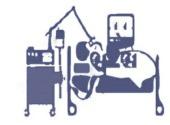
You are transferred to Barlow Respiratory Hospital, a long-term acute care hospital (LTAC/LTCH), for highly specialized care.
You are discharged to a Skilled Nursing Facility, Sub Acute Facility, Acute Rehabilitation, or Home Health Care to continue your recovery.

Your recovery journey may include several levels of care, and may include adjusting to changes in care location and levels of function.
We understand it can be a difficult journey.
We are here for you and welcome any questions you may have.
If visits need to be suspended due to public health or safety, Barlow Respiratory Hospital will work with family members to facilitate continued patient communication.
-Visiting Hours are flexible depending on the patient’s individual needs
Visitors may be asked to leave the room for patient treatment, care or when visiting hours are over.
ICU Patients may receive visitors 8:00 am to 9:00 pm depending on the condition of the patient. Visiting times are flexible for patient’s support person or representative.
Children under the age of twelve are not allowed to visit patients for their welfare and that of our patients.
Two (2) visitors per patient are allowed at a time.
If you have a special visiting hour request, please ask a member of the patient care team. Visitors are asked not to disturb other patients.
Visitors may not enter any restricted area unless accompanied by a staff member.
For the welfare of our patients and staff, please do not visit patients if you are ill, or recovering from a cold or the flu.
Visitors - please keep your valuables with you at all times.
Patients are urged to send all valuables home or have them placed them in the hospital safe.
Cafeteria HoursBreakfast 8:00 AM -10:00 AM, Lunch11:00 AM to 2:00 PM. Dinner trays are available and must be ordered from dietary before 3:00 PM.
Cafeteria open to visitors all day.
Closed 10:00-11:00 AM and 3:00-3:45 AM.
Cafeteria open between 6:00 AM to 6:00 PM. Mon -Fri, Weekends 8:00 AM - 2:00 PM. Vending machines are accessible 24 hours a day.
Cell phones are allowed in the hospital at any time. Please remember courtesy and confidentiality.
Los Angeles: South Lot Parking and Street Parking
Valley Presbyterian Hospital: Paid Valet and Self Parking
PIH Health Hospital Whittier: Free Valet and Self Parking
Public restrooms are available. Please ask a staff member to direct you to the nearest facility.
No weapons are allowed within any facility at any time.
Los Angeles and Valley Presbyterian: Smoking permitted in designated areas only.
PIH Health Hospital Whittier: Smoking isnot permitted.
Why would you or your loved one need a tracheostomy?
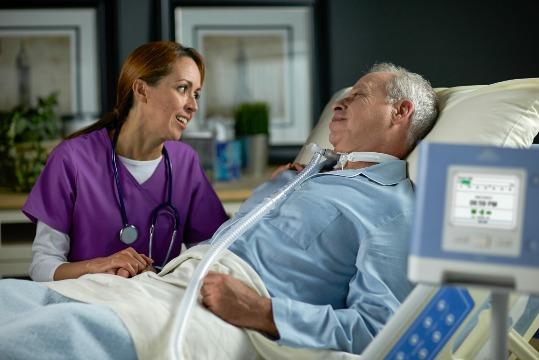
Your healthcare provider may recommend a tracheostomy when you cannot breathe on your own. This can happen in conditions like severe pneumonia, a massive heart attack or stroke. In such cases, you may need help from a breathing machine for more than a couple of weeks. At first, the breathing machine delivers air to the lungs through a temporary tube that goes into the windpipe through your mouth [entotracheal (ET) tube] (See ATS Patient Education Series on Mechanical Ventilation). However, if it is expected that you will need long-term help from a breathing machine, your healthcare provider may recommend switching the tube in the mouth to a tracheostomy tube.
Those with injuries (such as trauma or radiation) or a blockage in the windpipe (such as from cancer) may also need a tracheostomy. Usually, air enters through the mouth and nose, goes through the windpipe and into the lungs. In cases with an injury or a blockage to the windpipe, a tracheostomy tube can bypass the damaged part of the windpie and allow a person to continue to breathe on their own.
What are the benefits of a tracheostomy?
Breathing tubes through the mouth (endotracheal tube) can cause mouth ulcers and damage to the vocal cords (voice box). These complications increase the longer the tube is in place. Tracheostomy tubes reduce these risks.
Breathing tubes in the mouth are uncomfortable. People on ventilators usually require medications for pain and discomfort that can make them sleepy. It is also harder to interact with family members because of the side effects of these medications and the inability to talk with the tube in your mouth. Tracheostomies are usually more comfortable than tubes in the mouth and
you may require less medication. You may also be able to be more awake and interactive. In some cases, a special speaking valve (Passy Muir© valve) can be placed on the tracheostomy tube to improve speech even while on the ventilator.
Tracheostomy tubes can safely remain in place longer than endotracheal tubes.Tracheostomy tubes are more secure than tubes in the mouth. It is easier to take part in physical therapy and rehabilitation exercises, including sitting up in bed and walking with a tracheostomy tube rather than an endotracheal tube.
A tracheostomy is a surgery that creates an opening through the front of the neck into the trachea (windpipe). A tracheostomy tube is usually put through the hole in the windpipe. However, the word tracheostomy is commonly used to describe both the surgery and/or the tube. Tracheostomy tubes allow people who cannot breathe on their own to be connected to a ventilator (breathing machine) or receive additional oxygen. It also alows air to bypass an injury or blockage in the upper part of the windpipe to reach the lungs.
Short-term: Most of the short-term risks are related to the surgery. All surgeries have risks of bleeding and infection. There is also risk of damaging other areas of the neck. These risks are typically small and tracheostomy is overall a safe procedure. Complications are more common if patients are very sick, weak or malnourished. In the first week after the surgery, there is a higher risk of the tube coming out. This can cause severe consequences if you cannot breathe on your own by then. Many surgical risks are case-specific and you should discuss your own risk with your medical team.
Long-term: Over time, the tracheostomy tube can also cause some damage to the windpipe, which can cause problems if the tube is removed. The tracheostomy tube can sometimes cause breakdown of the area around the hole in the neck (this area is called the stoma). This can lead to infection and rarely, serious bleeding. Both tracheostomy tubes and endotracheal tubes increase the chance of pneumonia. A person who has a tracheostomy may be at higher risk for getting frequent pneumonias, especially if he or she has to stay in a hospital or a long-term facility for a while. Tracheostomy tubes can also irritate the windpipe and cause an increased amount of mucus production. This can lead to chronic issues with mucus blocking parts of the lung. Suctioning the tracheostomy tube can relieve this blockage. Getting good training for the caregivers who help care for a tracheostomy can help reduce or prevent some of these risks.
You will typically return to the ICU after the surgery if you still need support from a breathing machine. If the tracheeostomy is placed because of an injured or blocked windpipe, you may be watched on a regular hospital floor. The surgical site will heal over the first week after the procedure. Minor bleeding or scab formation for a few days is normal. About one week after the procedure, the tract between the skin and the windpipe heals. At this time, the tracheostomy tube may be switched out for a new one. This new tracheostomy tube should be removed, cleaned and replaced every so often to prevent the tube from being blocked by mucus or debris.
If the tracheostomy is done due to an injured or blocked windpipe, what happens after the tracheostomy depends on why it was placed. Some injuries can be repaired quickly with fast removal of the tube. If you need radiation therapy to the neck for cancer, the tracheostomy will often stay in place until the area heals from the radiation. However, if the tracheostomy was placed because of a blockage related to too much soft tissue in the neck (for example, obstructive sleep apnea), the tracheostomy tube will likely remain in place long-term.
Those who have a tracheostomy placed because they still need a breathing machine often have a different course. Even after most medical problems have been treated (for example, the patient recovers from severe pneumonia), you may still require some support from the breathing machine and intensive physical therapy. These patients may need to be discharged to a longterm care facility to slowly learn to breathe without help from a breathing machine, to continue any medical treatment and to have physical therapy.
How long will it take to breathe on my own after a tracheostomy and be disconnected from the ventilator?
If you require a tracheostomy for an injury or blockage to the windpipe, you are likely to be able to breathe on your own (through the tracheostomy tube) soon after surgery. If you cannot breathe on your own, it is difficult to predict how long you will need the breathing machine.
As you recover from the underlying illness, the amount of support from the breathing machine is gradually reduced (a process called weaning). You will likely go through a period where you are off the machine for parts of the day and back on at other times before you can permanently be taken off of the breathing machine. Ideally, the goal is to wean patients off the breathing machine entirely. However, it is possible that you may not be taken of off the breathing machine at all and may require long-term breathing support and ongoing hospital care. You should discuss issues about being taken off of the breathing machine with your medical team.
www.barlowhospital.org
Not for most people. Whether your tracheostomy tube can be removed depends on why it was placed. Once you are able to breathe on your own or if your injury/blockage to the windpipe is treated, you can start talking with your healthcare provider about removing the tube. After removal of the tracheostomy tube, the hole in the neck where the tube was placed often closes on its own. If the airway obstruction is permanent or you stillneedhelpfromabreathingmachine,the tracheostomy may be permanent.
Do I have to have a tracheostomy if my medical team believes I will need prolonged support from a breathing machine?
No, but the issue can be very complicated. Decisions about lifesupportandbreathingmachinesareverypersonalforeach of us. Some people would not want to be attached to machines for a long period of time and a tracheostomy may not be the right decision for them. In such cases, a transition towardcaredirectedatcomfortonly,asopposedto prolonging life with artificial means, may be appropriate. For others, the tracheostomyisthetoolthatallowsthemtofulfilltheirpersonal beliefs of doing everything necessary to prolong life.
Whether you forgo a tracheostomy and pursue comfort measures, or choose to have a tracheostomy is a highly personal decision based on your own values and beliefs. These decisions often fall to family members and “health care proxies” as patients are not able to communicate when on a breathing machine. It is important that your family and health care proxy know your wishes about long-term breathing support from a breathing machine so they can make decisions based on your values and beliefs.
(See ATS Patient Education Series on Palliative Care).

Authors: Anuj B Mehta, MD; Sohera N Syeda MD; Allan J Walkeym MD Msc; Renda S Wiener, MD MPH
Reviewers: Hrishikesh Kulkarni MD; Colleen McEvoy,MD; Marianna Sockrider Md, DrPh
If your health care provider is recommending a tracheostomy, you or your loved ones will want to review risks and benefits for you.
Expect to learn how to care for a tracheostomy tube to help reduce or prevent risks.
ATS Patient Education Series
www.thoracic.org/patients
● Mechanical Ventilation
● Palliative Care
● Tracheostomy in Child
MedLine Plus - Tracheostomy Care
https://www.nlm.nih.gov/medlineplus/ency/patient instructions/000076.htm

Breath of Life
http://www.bolhme.com/education/tracheostomyc are&suctioning.pdf
Barlow Respiratory Hospital is regarded as one of the top long-term care acute hospitals (LTAC) in the nation serving the chronically critically ill, and the destination of choice for weaning patients from prolonged mechanical ventilation.
Patients are referred to Barlow from over 70 hospital intensive care units (ICUs) in the Los Angeles metropolitan area and Southern California. Over 300 patients a year are discharged from our Ventilator Weaning Program. Our weaning success rate has been over 50% each of the last 10 years, 2009 – 2018.
Barlow was designated as the only Passy Muir Center of Excellence on the West Coast of the United States, recognized for treating patients with tracheostomies, on and off the ventilator.
As a long-term care acute hospital (LTAC), also known as a long-term care hospital (LTCH), Barlow can provide the same types of care as you/your family member received in the acute care hospital. The average number of days a patient stays at Barlow is 25-30 days. Our case manager will work with you and your family to establish your discharge plan to achieve the most complete recovery possible.
Barlow provides the opportunity for continued attempts to wean from the ventilator. Over half of the patients who come to Barlow for weaning are weaned in less than two weeks. We are well-known for our TIPS© weaning protocol. You will be assessed daily for weaning readiness and ability, but weaning attempts cannot continue indefinitely. It is our goal to wean you from the ventilator, but you could also be discharged partially
weaned, such as only on the ventilator at night, or discharged still ventilator-dependent. You will be discharged to the next level of care, whether that is home or to another facility, when your physician decides you are ready.
Our Ventilator Weaning Program teams work together to care for you. Your care team can consist of: critical care and pulmonary physicians, nurses, case managers, respiratory therapists, rehabilitation professionals (physical, occupational, and speech therapists), clinical dietitians, pharmacists, and social workers.
Welcome to Barlow, and let us know when you have questions or comments about how we are caring for you. We want to make a positive difference in your life!
Mechanical ventilation is a life-support treatment. A mechanical ventilator is a machine that helps people breathe when they are not able to breathe enough air on their own. The mechanical ventilator is also called a ventilator, respirator or breathing machine. Most patients who need support from a ventilator because of a severe illness are cared for in a hosptal’s intensive care unit (ICU). People who need a ventilator for a longer time may be in a regular unit of a hospital, a rehabilitation facility or cared for at home.

● To get oxygen into the lungs and body.
● To help the body get rid of carbon dioxide through the lungs.
● To ease the work of breathing - Some people can breathe on their own, but is very hard. They feel short of breath and uncomfortable.
● To breathe for a person who is not breathing because of injury to the nervous system, like the brain or spinal cord, or who has very weak muscles.
The ventilator is connected to the person through a tube (endotracheal or ET tube) that is placed into the mouth or nose and down into the windpipe. When the health care provider places the ET tube into the person’s windpipe, it is called an intubation. Some people go through surgery to have a hole placed in their neck and a tube (tracheostomy or “trach” tube) is connected through that hole. The trach tube is able to stay in as long as needed. At times, a person can talk with a trach tube in place by using a special adapter called a speaking valve. (For more information on having a tracheostomy see ATS patient information series at www.thoracic.org/patients).
The ventilator blows gas (air plus oxygen as needed) into the person’s lungs. It can help a person by doing all of the breathing or just assisting the person’s breathing. The ventilator can deliver higher levels of oxygen than delivered by a mask or other devices. The ventilator can also provide what is called positive end expiratory pressure (PEEP). This helps to hold the lungs open so that the air sacs do not collapse. The tube in the windpipe also makes it easier to remove mucus if someone has a weak cough.
A ventilator can be life-saving, but its use also has risks. It also doesn’t fix the problem that led to the person needing the ventilator in the first place; it just helps support a person until other treatments become effective, or the person gets better on their own. The health care team always tries to help a person get off the ventilator at the earliest possible time. “Weaning” refers to the process of getting the patient off the ventilator. Some patients may be on a ventilator for only a few hours or days, while others may require the ventilator for longer periods. How long you may need to be on a ventilator depends on many factors. These can include your overall strength, how well your lungs were before going on the ventilator and how many other organs are affected (like your brain, heart and kidneys). Some people never improve enough to be taken off the ventilator completely or at all.
The ventilator itself does not cause pain. Some people don’t like the feeling of having the tube in their mouth or nose. They cannot talk because the tube passes between the vocal cords into the windpipe. They also cannot eat by mouth when the tube is in place. A person may feel uncomfortable as air is pushed into their lungs. Sometimes a person will try to breathe out when the ventilator is trying to push air in. This is working (or fighting) against the ventilator and makes it harder for the ventilator to help.
People on ventilators may be given sedatives or pain controllers to make them feel more comfortable. These medicines may also make them sleepy. Sometimes medications that temporarily prevent muscle movement (neuromuscular blocking agents) are used to allow a person to breathe with the ventilator. These agents are typically used when a person has very severe lung injury. They are stopped as soon as possible, and always before ventilator support is removed.
Anyone on a ventilator in an ICU setting will be hooked up to a monitor that measures heart rate, respiratory rate, blood pressure and oxygen saturation (02sats). Other tests that may be done include chest x-rays and blood drawn to measure oxygen and carbon dioxide (blood gases”). Members of the health care team (including doctors, nurses, respiratory therapists) will use this information to assess the patient’s status and make adjustments to the ventilator if necessary.
Infections - The ET or trach tube allows germs (bacteria) to get into the lungs more easily. This can cause an infection like pneumonia. Pneumonia can be a serious problem and may mean a person has to stay on the machine longer. Pneumonia can often be treated with antibiotics. See ATS Fact Sheet on Pneumonia at 222.thoracic.org/patients.
Collapsed lung (pneumothorax) - Sometimes a part of the lung that is weak can become too full of air and start to leak. The leak lets air get into the space between the lung and the chest wall. Air in this space takes up room so the lung starts to collapse. If this air leak happens, the air needs to be removed from this space. A different kind of tube, (chest tube) can be placed into the chest between the ribs to drain out the extra air. The tube allows the lung to re-expand and seal the leak. The chest tube usually has to stay in for some time to make sure the leak has stopped. Rarely, a sudden collapse of the lung can cause death.
Lung damage - The pressure of putting air into the lungs with a ventilator can damage the lungs. Doctors try to keep this risk at a minimum by using the lowest amount of pressure that is needed. Very high levels of oxygen may be harmful to the lungs as well. Doctors only give as much oxygen as needed to make sure the body is getting enough to supply vital organs. Sometimes it is hard to reduce this risk when the lungs are damaged. However, this damage may heal if a person is able to recover from the serious illness.
Side effects of medication - Sedatives and pain medications can cause a person to seem confused or delirious and these side effects may continue to affect a person even after the medications are stopped. The health care team tries to adjust the right amount of medication for each person. Different people will react to each medicine differently. If an agent to prevent muscle movement is needed, the muscles may be weak for a period of time after the medication is stopped. This may get better over time. In some cases, the weakness remains for weeks to months.
Inability to discontinue ventilator support - Sometimes the condition which led a person to need a ventilator does not improve despite treatment. When this happens, the health care team will discuss your treatment preferences regarding continued ventilator support with you, or with your family, if you are not able. In a situation where a person is not recovering or is getting worse, a decision may be made to discontinue ventilator support and allow death to occur.
for only a short time, but some people cannot be weaned off of the ventlator and do not want to stay on the machine. Other people who know they have a severe lung or health problem may not want to use a ventilator at all because the ventilator cannot fix their underlying condition.
Some people have very specific thoughts about if and when they should be placed on a ventilator. Although the heath care team helps people and their families make tough decisions about the end of life, it is the person, him or herself, who has the final say. If a person cannot talk or communicate decisions, the healthcare team will talk with their legally authorized representative (usually a parent, wife, husband, adult child or next of kin).
It is important that you talk with your family members and your health care provider about using a ventilator and what you would like to happen in different situations. The more clearly you explain your values and choices to loved ones and the health care team, the easier it is for them to follow your wishes if you are unable to make deisions for yourself.

Advance directives are ways to also put your wishes in writing to share with others. In the hospital, nurses, doctors and social workers can provide information about an advance directive form. You can also obtain information on advance directives from our primary care provider, State Attorney General’s office, public health department or organizations such as Aging With Dignity (www.agingwithdignity.org) and PREPARE for your Care (https://www.prepare foryourcare.org/#1).
Source: Manthous, c., Tobin, MD, A Primer on Critical Care for Patients and Their Families.1st issued in 2001; 2017-2018 Update to be posted on www.thoracic.org/ patients.
Mechanical venentilation is a “life-sustaining treatment”. It is a treatment that can prolong life. It may be needed
Barlow Respiratory Hospital is a regional weaning center with an absolute focus on the treatment of post-ICU patients. We are pioneers in the specialized care of the chronically critically ill. Our high volume of patients served has helped us build expertise and develop innovative approaches to treat ventilator-dependent patients, most notably our published TIPS© weaningprotocol.
We are noted for our consistent ventilator weaning success rate of over 50% each of the last 12 years. When compared to regional and national rates, our percent of patients weaned is higher than the Pacific Region, and the nation.
We never lose sight of how this impacts our patients and their families. Each time a patient regains the ability to breathe on their own, each time a family enjoys the gift of more time with a loved one, we are reminded of the importance of our work and reaffirm our dedication to excellence and innovation.


Most patients who need care in the ICU get better quickly. After a few days in the ICU, they no longer need a ventilator or other critical care treatments. But even with the best ICU care, some patients remain critically ill and have trouble breathing on their own, without a machine, for a much longer time. These patients have chronic critical illness.
We do not always know why some ICU patients get better quickly whereas others remain critically ill and need a ventilator for a long time. Medical problems that people have before being hospitalized can be a factor. New problems that develop during the hospitalization can also hinder recovery. We are learning how to take better care of patients with chronic critical illness and their families. We are also learning more about what to expect from treatments that exist today.
There is no test to diagnose chronic critical illness. Doctors and nurses know that adult patients have chronic critical illness when they still need a ventilator after about 2 weeks of treatment in the ICU. For most patients, chronic critical illness also involves many body systems and organs (which can result in skin changes, weakness, confusion, and increased risk of infections).
Treating chronic critical illness involves caring for the total person ratherthan administering a single medication or procedure. The goal of care is, if possible, to free patients from the ventilator, from other , and from the need for more help with everyday activities than they needed before this illness. Doctors, nurses, and other members of the critical care team try to help the patient become free of the ventilator in small steps (often called ) They also provide feeding through a tube, skin care, and other types of care for infections They try to prevent new infections and other problems although, unfortunately, this is often very difficult and unsuccessful
Patients will stay in the ICU initially, but often patients with chronic critical illness are transferred to another unit in the hospital or to another facility outside the hospital that specializes in caring for these patients This will depend on the patient’s situation and on the hospital and city
In time, about half of patients with chronic critical illness are able to breathe on their own without a ventilator. The rest of the patients will always need the ventilator to help with breathing. The chances of being free from the ventilator decrease as time goes by. Each patient is different, and it is not always easy to predict how things will turn out. Feel free to ask the medical team for their opinion about what is likely to happen to your family member in the future.
Having intensive treatment for a long time may be difficult for patients. They may feel frustrated because they cannot talk or eat regular food. Some patients report distress or discomfort caused by pain. Some have difficulty sleeping. Some are depressed. Doctors, nurses, and other members of the healthcare team try to keep the patient comfortable and free of distress. However, the illness is still difficult for many patients.
In the early phase of critical illness in the ICU, many patients receive medicines (sedatives) to make them less anxious or as part of the treatment for their medical condition. Sedatives make patients less alert. The doses of these medicines are often lowered or stopped as time passes, so patients can be more awake. Patients with chronic critical illness can also be confused or unconscious from other illnesses or medications. You can ask the medical team how alert the patient is and whether there are times of day when he or she is most alert (often this fluctuates). You can also ask how much the patient understands what is happening. Adapted from Society of Critical Care Medicine 2010 – Barlow Respiratory Hospital
Patients who survive treatment for chronic critical illness are weaker after treatment than they were before they came to the ICU. Very few of these patients can return directly home from the hospital. In fact, most patients never recover their previous strength and function. The majority are unable to do basic daily activities (such as eating, using the toilet, bathing) by themselves. Most cannot live independently and need to be in a nursing home or other type of care facility where most or all of their care is provided by others.
Long critical illness is hard on the family as well as the patient. You may feel stress, worry, sadness, or fatigue. Some families worry about financial burdens or stress on family relationships. They face many challenges when giving long-term care. You can ask for meetings with a social worker or other hospital staff members to get help with your concerns.
Yes. Patients who survive initial treatment in the ICU remain at higher risk of dying. Doctors worry most about patients who are elderly and about those who still need life supports like the ventilator, even after many attempts to help these patients come off life support. Most patients have trouble fighting infections. More than half of patients with chronic critical illness die within 6 months. Even if the patient is treated and slowly begins to breathe without the help of the ventilator, the effects of chronic critical illness can be severe and are often permanent.
Like any patient, the patient with chronic critical illness has the right to make decisions about treatments that may be offered by the healthcare team. If the patient cannot make decisions, someone else who is approved to make decisions, such as a healthcare proxy or family decision maker, has the right to be involved in treatment decisions and help the doctors and nurses understand what the patient would want if he or she could decide personally. In the case of a child, decisions are made based on what is in the child’s best interests. To make the best decisions for your family member, you need information about what treatment options are available. You can learn about the benefits, risks, and burdens for each option.
You are encouraged to ask questions. Talk with the healthcare team about the patient’s situation and chances of getting better. Decisions made at one point in time can be changed at a later time. You may also wish to discuss, either now or later, the option of stopping intensive treatments such as the ventilator while keeping the patient comfortable. The needs and concerns of the family as well as the patient are important throughout this process.
A ventilator helps the lungs breathe and provides oxygen. When patients are first put on this machine, they are usually connected to it by a tube that goes through the mouth and vocal cords (in the larynx, or voice box) into the trachea (windpipe). If the patient needs a ventilator for a long time, the ICU team may advise that this tube be moved from the patient’s mouth to the neck. Surgery is done on the neck to make an opening and place a tube directly into the trachea below the vocal cords; the breathing tube is removed from the mouth, and the patient is still connected to the ventilator. Surgery may be done at the bedside in the ICU or in an operating room. The opening in the neck is called a

If a tracheostomy is being discussed for your family member, you can learn about the likely risks and benefits of this procedure. You can talk about the decision with the ICU team and the surgeon who would perform it. Placing a tracheostomy does not make a sick patient better— it is not a treatment for a medical condition. It is a necessary procedure if a patient needs to stay on a ventilator longer than approximately 2 weeks. If tracheostomy is being discussedbecause the patient is still on a ventilator with chronic critical illness (there are reasons besides chronic critical illness why a tracheostomy may be recommended— those situations can be different), you should also try to understand more about chronic critical illness and the risks and benefits of being on a ventilator for a long time.
The doctors and nurses on the critical care team can provide facts, advice, and support. Help from a social worker or chaplain may also be valuable. Ask for information and assistance. Adapted from
Barlow Center for Wound Healing manages difficult-to-heal wounds that can complicate treatment of other serious conditions including cardiac, pulmonary, neuromuscular, endocrine, and renal diseases.
Barlow wound care is comprehensive and interdisciplinary in scope. The Barlow team applies state-of-theart care to the actual wound and addresses underlying causes. Daily physician visits and a full range of therapies improve the quality of life and maximize function and well-being. Treatment and healing interventions for complicated wounds include:
● Pressure Injuries
● Stage III Pressure Ulcers
● Stage IV Pressure Ulcers
● Surgical Wounds
● Traumatic Wounds
● Fistulae
● Abscesses
● Complex Wounds/Osteomyelitis
● Post-Amputation Wounds
● Necrotic Conditions
● Wounds Complicated by Existing Diseases
● Wounds Requiring Highly Technical Care
● Wounds Requiring Nutritional Support
● Wounds Requiring Complex Dressings
Barlow’s Wound Care specialization creates realistic hope for improvement and engages our entire clinical team. This is another example of how our commitment to excellence makes a difference in the lives of patients and families.


Pressure injury (aka pressure ulcer, pressure sore, or bedsore) is damage to the skin and the underlying tissue usually over a bony area. The injury can present as intact skin or an open ulcer. Pressure injuries often happen if you lie or sit in one position for a long period of time. They can be painful and heal slowly. But you can do many things to help stop pressure injuries.
Anyone who cannot move around on their own is at risk for pressure injuries. The biggest risk factors are:
•Staying in a bed or wheelchair

•Not being able to change positions without help from someone else
Other Risk Factors:
● Skin irritation from loss of bladder or bowel control
● Poor nutrition
● Vascular disease
● Smoking
● Diabetes
● Certain medications and use of various medical devices
Pressure sores form where bone presses your skin against a bed or chair. This is most likely to happen in places where there is less padding between the skin and the bone. This includes your head and feet, and
Pressure injuries can develop quickly, even in healthy skin. Taking steps to prevent them is important. Taking pressure off your skin is the first step.
Changing positions often allows blood to get to your skin and keep the tissue healthy.
Shift weight from side to side, at least once an hour, every15 minutes if possible.
Ask about pads and cushions that can reduce pressure on your skin.
Change positions at least every 2 hours, more often if possible
Use lightweight sheets and blankets. The weight of the blanket may develop pressure injuries in susceptible areas.
Ask about special pads and mattresses that spread pressure over a larger area of your body.
Keep your sheets smooth, dry, and free of wrinkles.
Keep your feet and head slightly raised to avoid sliding. When on bed rest, don’t raise your head more than 30 degrees, except when needed for some medical conditions or for eating.
Keep your skin free of sweat, urine, or wound drainage.
Apply protective creams and use absorbent pads if you don't have bladder or bowel control.
Lightly cushion your back and buttocks. Don’t use doughnut-type cushions. They can cut off the blood supply to your skin.
Lightly pad the footrest on your wheelchair.
Do skin checks twice a day as part of your daily routine. Skin breakdown starts with slight changes, but can progress very quickly. Look for
, especially over bony areas.
Using a specialty mattress.
Inspecting your skin every shift for signs of pressure injury.
Keep your elbows slightly bent. When lying on your side, put pillows/wedge behind your back, between your legs, and between your ankles. Keep elbows and knees slightly bent.
Rubbing (friction) and sliding (shear) cause the skin to break down more easily.
Keep your feet on a footrest, so your thighs are horizontal. This keeps your buttocks from sliding forward.
Support your shoulder blades and back with a pillow.
Keeping your skin clean and dry. Moisturizing your dry skin. Reminding you to change position at least every 2 hours.
If you cannot move without help, caregivers will change your position in bed every 2 hours.
Using heel protectors.
Keeping the head of your bed no more than 30 degrees as tolerated.
Using a skin protectant to protect the skin from urine or stool.
Getting a well-balanced diet and fluids. Informing your nurse or doctor if signs of skin breakdown are noticed.
When you are admitted to the hospital, and every day of your stay, your health care team will look closely at your skin to determine if you have a pressure injury. This is also called a bedsore, pressure ulcer, pressure sore, or decubitus ulcer. This is a breakdown of skin and tissue. Pressure injuries can happen when you are unable to change position, when you are seriously ill, or when you must stay in a bed or a chair for a long time. If you have been diagnosed with a pressure injury, here are some of the steps that may be taken for healing.
Your doctor and a Wound Care Certified (WCC) nurse will look closely at your skin to decide if you have a pressure injury, and if so, to assign a “stage” to the wound. Staging helps determine what treatment is best for you. You will also have blood tests to assess your general health.
Your doctor and WCC nurse will review your medical record and may ask questions to determine:
When did the pressure injury first appear?
Do you have any pain?
Have you had pressure injuries in the past?
How were they managed, and what was the outcome of treatment?
What is your routine for changing positions?
What medical conditions have you been diagnosed with, and what is your current treatment?
What is your nutrition care plan?
What kind of care assistance is available to you after discharge?
Treating pressure injuries involves reducing pressure on the affected skin, caring for wounds, preventing infection, controlling for pain and maintaining good nutrition.
Members of your treatment team might include:
Doctor who oversees your treatment plan
Wound Care Certified (WCC) registered nurse
Registered nurses and assistants who provide care and education for managing wounds
Physical therapist who helps with improving mobility
Occupational therapist who helps to ensure appropriate seating surfaces
Registered dietitian who develops and monitors your nutrition care plan
Social worker who addresses emotional concerns related to long-term recovery
Respiratory therapist who monitors your skin under any respiratory-related medical devices
Case manager who helps you and your family access any needed resources
Doctor who specializes in conditions of the skin, or plastic, vascular, or orthopedic surgery
The first step in treating a pressure injury is reducing the pressure and friction that caused it. Strategies include:
• Repositioning: If you have a pressure injury, turn and change position often. How often you reposition depends on your condition and the bed surface you are on.
• Using support: Use a mattress, bed surface, and special cushions that help you sit or lie in a way that protects vulnerable skin.
Care for pressure injuries depends on how deep the wound is. Generally, cleaning and dressing a wound includes the following:
• Cleaning: If the affected skin isn’t broken, wash it with a gentle cleanser and pat dry. Clean open sores with water or a saltwater (saline) solution each time the dressing is changed.
• Putting on a bandage: A bandage speeds healing by keeping the wound moist. It also creates a barrier against infection and keeps skin around it dry. Bandage choices include films, gauzes, gels, foams, and treatment coverings. You might need a combination of dressings.
To heal properly, wounds need to be free of damaged, dead, or infected tissue. Your doctor or nurse may remove damaged tissue (debride) by gently flushing the wound with water or cutting out damaged tissue.
A large pressure injury that fails to heal might require surgery. Your doctor and WCC registered nurse will inform you if a method of surgical repair is the right treatment for you.
Follow the advice of your health care team regarding changing positions, supporting your body, keeping your skin clean, and a healthy diet. Let your health care team know if you have any pain, trouble with bladder or bowel control, changes in your appetite, food preferences, or questions about your treatment and care plan.
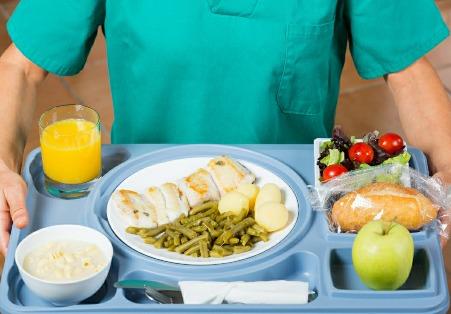
Having a wound puts extra demands on your body. To heal, you need more calories and more nutrients. Wounds heal faster if you get enough of the right foods — and if you don’t, they heal more slowly. Your Registered Dietitian Nutritionist (RDN) has made a nutrition care plan just for you, based on your specific medical conditions. Follow the guidelines below to promote healing and recovery.
Every day, try to eat foods from a variety of sources that include the following:
• provides the building material for muscle and skin repair. It also helps boost immunity. (One serving is 3 to 4 ounces.)
Good sources of protein include:
– Lean meat, such as beef, pork, chicken or fish
Dried beans, peas, lentils, or tofu
– Nuts, peanut butter, or seeds
– Cheese, yogurt, or eggs
• supply the energy your body needs to heal. Good choices include:
Whole grain breads and cereals
– Potatoes, rice, or pasta
A variety of fruits and vegetables
– Foods with vitamin A, such as bright orange fruits and vegetables, and dark green leafy vegetables
– Foods with vitamin C, such as citrus fruits
• are good sources of both carbohydrates and protein. If you are not able to, or do not like to eat dairy, be sure to include at least 3 servings per day. One serving of milk or yogurt is one cup. Soymilk can be substituted for regular milk.
• is critical to wound healing — and you need more than usual. Water replaces fluid lost with draining wounds. Drink about 6 to 8 cups per day, unless your RDN or doctor tells you otherwise.
You can get most of the vitamins and minerals you need from eating a well-balanced diet, as described above. Be sure to eat at least one serving per day of meat or other protein, fortified cereals, or dark green leafy vegetables, peppers, tomatoes, strawberries, cantaloupe, and broccoli.
If you’re not eating at least 5 servings a day of fruits and vegetables, your doctor or RDN may recommend a daily multi-vitamin. Only take other vitamins or minerals if recommended by a healthcare provider.
Some people have trouble eating enough at meals to promote wound healing. Your RDN can suggest and help you choose some ideas that may help:
• It may be easier to eat 6 small meals per day rather than 3 larger meals. Consider having something to drink after you eat instead of before. This may keep you from getting full too soon.
• Help get the nutrition you need by snacking between meals on healthy foods such as:
– Cheese and crackers
– Cottage cheese and fruit
– Tuna, chicken, or egg salad
– Hard-boiled eggs
– Mixed nuts or trail mix
– Half a sandwich and a small piece of fruit
– Peanut butter and sliced apples
– Granola or protein bars and fresh fruit
• If you’re still having trouble getting the protein or calories you need to help you heal, your RDN will talk with your doctor about a nutritional supplement.
Supplements with high-quality proteinare available as flavored drinks, puddings, and yogurts or as unflavored powder that you can sprinkle over food. There are also some supplements that are better for people with diabetes.
•
Some people have trouble eating enough on their own to meet their nutritional needs and promote wound healing. This may be due to your medical conditions, and/or difficulty swallowing. Your doctor may have placed a feeding tube into your stomach to help you take in nutrition and medicine that can no longer be taken by mouth, or into a vein (IV) if are unable to be fed into the stomach.
• Gastrostomy tube (G-tube), jejunostomy tube (J-tube), nasogastric tube (NG tube)
• Total parenteral nutrition (TPN), peripheral parenteral nutrition (PPN)
Your RDN will work with your doctor to choose the best feeding formula and amount for you based on your medical conditions and nutritional needs. Both of these types of feedings can provide all of the calories, protein, fluid, and other nutrients you need for healing and recovery.

We know that being hospitalized can be a stressful experience. Our goal is to make your stay with us as comfortable and pleasant as possible. Your safety is of utmost concern. You and your family are an integral part of the health care team. We will work with you to provide a safe environment.
We encourage you, your family, and our staff to speak up if there is a safety concern. We welcome the opportunity to discuss the care for patients and to develop mutually agreed upon goals.
This information tells you and your family how you can assist us in providing a safe environment.
● Please let the doctor and hospital staff know of any allergies or sensitivies to food, medications, or latex products.
● Make sure to wear your hospital identification band at all times. If you lose it or it is removed for some reason, please alert the nursing staff so that we can get you another one.
● Please do not hesitate to ask your doctor or hospital staff for information if you are unclear about the reason or purpose of a test or treatment. You have a right to this information. Don’t hesitate to ask.
● Please observe the safety precautions that have been designed as part of your treatment plan. For example, you may be asked not to get out of bed without someone assisting you.
● A call light has been provided to you so that you can summon assistance if needed. Please be sure to keep the call light within your reach. Do not hesitate to call for assistance for any reason.
● You should receive information about results of tests and procedures. Ask the doctor or nurse about the results.
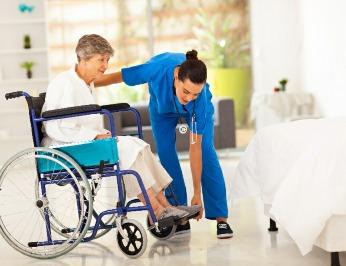



● Keep your bed in the low position.
● Keep side rails up while in bed.
● Slowly rise from sit to stand/pushing up bed or chair to ensure you are not dizzy.
● Ensure wheelchair brakes are locked to transfer into wheelchair and while getting out.
● Do not sit too close to the edge of the bed to reach for objects on the bedside table, etc.
● Ensure there is not a spill/wet surface around you prior to standing.
● Always use proper footwear with non – skid soles.
● Always call for help if instructed to do so, use your call button and wait for assistance.
● Be careful walking in the room and going to the bathroom. Call for assistance if unsure.
● Please try to give yourself enough time and try not to rush.
● Never bend over to pick up anything.
● If walking in the hallways, use side rails, or walker, as instructed and pace yourself.
● Never go out alone.
● Never use equipment unsupervised
Tell your doctor and nurses about all the medications you take, including over-the-counter medications, vitamin and herbal supplements. All medications taken by you prior to coming to Barlow Respiratory Hospital will be reviewed.

If you were taking medications at home prior to being hospitalized, please tell the physician or nurse or have your family discuss medications taken for chronic conditions such as diabetes, thyroid medications. lnform your physician, nurse. or respiratory therapist about food and drug allergies or adverse reactions to medications.
The pharmacy department provides patients with unit of use medications whenever possible. Some medications may sometimes look different than what you have at home. If medications appear different, ask the nurse or respiratory therapist for information about medications being taken to know why it is being administered, and the name and color of the medicine.
Ask what the results should be of taking the medication and possible reactions. Ask about the side effects of medication. If the medication does not work as you expected, ask the nurse or pharmacist about it. Your identification will be checked prior to administering any medication.
Prior to discharge you and/or your family member or home caregiver will receive information on each medication to be taken at home, including purpose of drug, dose, time to be taken, and side effect that should be reported to your physician. A complete list of medications will be given to you or your family member before you are discharged home.
Please inform staff if there are any problems filling prescriptions so there are no missed medications doses upon discharge. If going to a subacute or skilled nursing facility, a complete list of medications will be given to the receiving facility upon discharge.
Our patients have many “tubes” - intravenous (IV) lines, feeding tubes, airway/ventilator tubes, oxygen lines, urinary catheter tubes, etc. Keeping these lines and tubes working properly is a priority. If you find a tube that has come apart or if you see a tube that doesn’t look right, do not try to reconnect it. Please call the nurse or respiratory therapist to fix the problem.
Relieving your pain and discomfort is important to us. Keeping pain under control helps you to recover faster with fewer problems. Some pain is unavoidable, but most pain can be prevented or reduced. Our goal is to do everything possible to decrease your pain and discomfort during your hospitalization.
The staff will ask you for a “functional pain goal or pain goal.” On a scale of 0-10, a functional pain goal is the amount of discomfort you feel you can tolerate and still be able to function.
Pain management can include non-drug interventions (such as massage, relaxation, meditation, or spiritual support) and/or pain medications. If you are in pain, you need to tell your doctor or nurse right away. Using pain medication or non-drug interventions before the pain becomes severe usually improves your ability to be pain free.
Following pain interventions, your nurse will reassess your pain. If the intervention does not work, a change in your care plan may be needed. The dose of the medication or the medication itself may need to be changed. Your doctor and nurse will be observing you for possible side effects of the medication. Let them know if you are experiencing an upset stomach, sleepiness, or constipation. These side effects may be controlled or prevented.
— OUR COMMITMENT TO YOU —
Each time we assess your level of pain, we will be asking you to use one of the following pain rating scales to make it easier for you to tell us the amount of pain you are in. Belo w are some of the scales we use to rate your pain.
Call us before your pain feels out of control
Help your doctor/ nurse assess your pain by using one of the following pain rating scales

Each time we assess your level of pain, we will be asking you to use one of the pain rating scales below to make it easier for you to tell us the amount of pain you are in. Below are some of the scales we use to rate your pain.
Tell your doctor/ nurse if your pain is not adequately relieved


Tell us how you feel after you have taken your pain medication
● Call us before your pain feels out of control
● Help your doctor/nurse assess your pain by using one of the following pain rating scales

● Tell your doctor/nurse if your pain is not adequately relieved
● Tell us how you feel after you have taken your pain medication

Patient safety is very important. Patient’s rights, dignity and well-being are also important. Your loved one has the right to be free of restrictions to movement. Despite our efforts we may need to use restraints to provide a safe environment.
Restraints limit the ability to move but they also limit the ability to pull out vital medical devices needed for medical treatment.
Examples of medical devices include:
● Feeding tubes
● Tracheostomies
● Urinary catheters
● Intravenous catheters
Before applying restraints we make every effort to use alternative measures such as:
● Providing reassurance
● Diversional activities
● Use of pillow support
● Relocation of room/environmental modification
● Re-orientation
● Medication review
● Limiting access to medical devices
● Psychosocial intervention
We do not choose to use restraints unless absolutely necessary. The physician and the rest of the team are involved in the decision process.
Consequences of not using restraints could include:
● Interruption in needed medications and nutrition
● Trauma and bleeding
● Inability to breathe
To provide for safety we want to include you in the plan of care. You know your loved one the best and we welcome any suggestions of how we can best protect them from harm. You may choose to remove the restraint while you are with your loved one. Just remember to let us know when you leave so we can re-apply the restraint.
Please feel free to discuss any concerns with us and your physician.
During your hospital stay your doctor may determine you need a special procedure. This may be done at the bedside, in our Special Procedure Room or in our Intensive Care Unit.
Your doctor will discuss your procedure with you and explain the benefits, risks and possible alternatives for the procedure. If you have any questions, please let us know so we can have your physician answer all your questions prior to your procedure. After all your questions are answered you will be asked to sign a consent for your procedure.
We recognize there is risk whenever you undergo a procedure and we take every precaution to assure your procedure goes well.
1.We ensure our physicians and staff have the appropriate credentials and training to perform the procedure and to provide care during and after the procedure.
2.We have a pre-procedure verification process which is performed at various time points such as when the procedure is scheduled, before you are transferred for the procedure and just before the procedure is performed where we ensure that everything needed for a successful procedure is in place.
3.If you are having a procedure that necessitates a puncture or incision in your skin, we follow the most up-to-date preparation techniques and post-procedure care to prevent an infection. You can help prevent infection by washing your hands before and after touching your wound or dressing, letting us know if your dressing becomes soiled, wet or comes off and performing the care as instructed when you go home.
4.We encourage your active involvement in the procedure preparation process such as participating in marking the site and participating in the “timeout” done just before the procedure to confirm everything is correct.
Sometimes there may be pain after a procedure. Let us know as soon as possible if you are experiencing any pain so we can keep you comfortable.
Please tell us about any concerns you may have about your procedure so we can provide the support you need.
When a patient, family, or caregiver is concerned about a sudden condition change of a patient and feels that the patient needs immediate intervention, he/she can ask the patient’s primary nurse to call for help from a rapid response team.
A rapid response team may consist of the nursing house supervisor, floor nurse manager, floor nurse team leader, respiratory therapy team leader, other registered nurses, and other respiratory therapist on duty. You know your loved one the best. If you feel there is something that is not right, discuss it with the nurse or respiratory therapist.

Sudden changes in a patient’s condition may include:
● Decrease in responsiveness, including new onset of slurred speech or difficulty arousing
● Heart rate fluctuation from more than 20% of baseline
● Drop in systolic blood pressure to below 90 mmHg
● Decrease in respiration to less than 8 breaths per minute
● Sudden increase in respiration to more than 30 breaths per minute
● Signs of new onset, repeated or prolonged seizures
Rapid Response Team Goals
● Reduce cardiac and/or respiratory arrests in the hospital
● Reduce unplanned transfers to higher level of care
● Reduce unanticipated adverse outcomes
● Reduce unplanned prolonging of hospital length of stay

Barlow Respiratory Hospital is committed to providing you with the best care. There are bacteria, or germs, both inside and outside hospitals. Bacteria that are antibiotic resistant are of special concern because they can cause infection while patients are receiving medical care. Antibiotic-resistant bacteria is a community, hospital, and worldwide problem. People can carry these germs in or on their body without symptoms. These bacterium can unknowingly be passed from patient to patient if important steps are not taken. A very serious bacterium that may be resistant to many antibiotics is Methicillin-Resistant Staphylococcis Aureus (MRSA).
It is important for your healthcare providers to know if you are carrying MRSA, so specimens will be collected for MRSA tests.
If you are found to carry MRSA or other antibiotic-resistant organism, you will be placed in contact isolation.

Contact isolation is one was to help us prevent the spread of antibiotic-resistant bacteria in the hospital. This means that health care staff (doctors, nurses, lab and radiology personnel, etc.) and visitors will be required to wear isolation gowns and gloves while caring for you. Another way to prevent the spread of germs is by washing your hands before and after patient care.
Our staff is working hard to protect you from infection while you are in the hospital. So help us protect you and your loved ones by washing your hands before and after visiting and by using personal protective equipment as instructed by staff. Please feel free to ask questions. We are here to help.



The CDC guidelines contain two basic tiers of precautions. The first and most important are those precautions designed for the care of ALL patients regardless of their diagnoses or presumed infection status. These are outlined below:
Previously referred to as “Universal Precautions,” Standard Precautions apply to all patients receiving care in hospitals regardless of their diagnoses or presumed infection status.
Hand Hygiene
Wash hands with soap and water. Apply alcohol gel if hands are not visibly soiled.
Gloves
Wear gloves when touching blood, body fluids, secretions, excretions and contaminated items. Wash hands immediately to avoid transfer of microorganisms to other patients or environments.
Wear a mask and eye protection or a face shield to protect mucous membranes of the eyes, nose and mouth during procedures and patient-care activities that are likely to generate splashes or sprays of blood, body fluids, secretions and excretions.
Gown
Wear a gown to protect skin and to prevent soiling of clothing during procedures and patient-care activities that are likely to generate splashes or sprays of body fluids, secretions or excretions. Remove a soiled gown as promptly as possible.
For patients known or suspected to be infected or colonized with epidemiologically important pathogens that can be transmitted through the air or by direct contact.
Airborne Precautions
Droplet Precautions
Contact Precautions
These precautions may be combined for diseases that have multiple routes of transmission. In all cases, they are used in addition to Standard Precautions.
In addition to Standard Precautions, use Airborne Precautions for patients known or suspected to be infected with micro-organisms transmitted by airborne droplet nuclei.
Examples of illnesses requiring Airborne Precautions include measles, varicella (chicken pox or disseminated herpes zoster/shingles), and TB (Tuberculosis).
Patient Placement
Place the patient in a private room that has monitored negative air pressure or monitored high efficiency filtration (HEPA filter) of room air. Keep room door closed and the patient in the room.
Wear the N95 mask when entering the room of a patient with known or suspected TB, chicken pox or measles.
This is in addition to Standard Precautions for a patient known or suspected to be infected with microorganisms transmitted by droplets. Droplets are large particles that can be generated by coughing, sneezing, talking or by the performance of certain procedures such as suctioning and bronchoscopy. Transmission occurs when droplets containing microorganisms generated from the infected person are propelled a short distance through the air (usually less than 3 feet) and are deposited on the host’s conjunctiva, nasal mucosa or mouth.
Examples of illnesses requiring droplet precautions are Invasive Haemophilus influenzae Type B disease, pneumonia, Pertussis, Mumps, Rubella, Strep pneumonia in infants and young children.
Wear a mask when working within 3 feet of the patient.
In addition to Standard Precautions, use Contact Precautions for patients known or suspected to be infected or colonized with specified epidemiologically important microorganisms that can be transmitted by direct contact with the patient or indirect contact with environmental surfaces or patient care items in the patient’s environment.
A patient with an infection is someone who has a positive wound, blood, urine, intestinal or pulmonary cuture that has a clinical picture of fever, pain, malaise, nausea, vomiting, rashes or pustules. A patient that is colonized with an important pathogen is someone who has a positive culture, but shows no signs of infection present such as fever, pain, draining wound or CXR infiltrates.
Examples requiring Contact Precautions include patients infected or colonized with multi-drug resistant bacteria, such as VRE and MRSA (MRSA also requires use of a mask). Patients with Clostridium Difficile; patients with Hepatitis A who are diapered or incontinent, patients with skin infections that are highly contagious, including scabies and disseminated herpes zoster.
Special Precautions: In addition to using Standard Precautions, Contact Precautions require placement of the patient in a private room or with a patient with the same organism and wearing gloves whenever entering the room. Wash hands again outside the patient’s environment.
In addition to wearing a gown as outlined under Standard Precautions, wear a gown when entering the room of a patient in Contact Isolation if you anticipate that your clothing will have substantial contact with the patient, environmental surfaces or items in the patient’s room, or if the patient is incontinent has diarrhea, an ileostomym, a colostomy or wound drainage not contained by a dressing. (Gown is mandatory for VRE and MRSA).
Mask
A surgical mask covering the nose and mouth is recommended for MRSA in the respiratory tract.

• Use soap and warm water. Rub your handsreally well for at least 20 seconds. Rub your palms, fingernails, in between your fingers, and the backs of your hands.

•If your hands do not look dirty, clean them with alcohol-based hand sanitizer. Rub the sanitizer all over your hands, under your nails and between your fingers until your hands are dry.
•Clean your hands before touching or eating food. Clean them after using the bathroom, taking out the trash, changing a diaper, visiting someone who is ill, or playing with a pet.
•Health care providers should wear clean gloves when they perform tasks such as taking throat cultures, pulling teeth, taking blood, touching wounds or body fluids, and examining your mouth or private parts. Don’t be afraid to ask them if they should wear gloves.
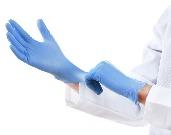
•Cover your mouth and nose to prevent the spread of infection to others.
•Use a tissue! Keep tissues handy at home, at work and in your pocket. Be sure to throw away used tissues and clean your hands after coughing or sneezing.

•If you are sick, stay away from other people or stay home. Don’t shake hands or touch others.
•When you go for medical treatment, call ahead and ask if there’s anything you can do to avoid infecting people in the waitingroom.
Make sure that your vaccinations are current—even for adults. Check with your doctor about shots you may need. Vaccinations
• Flu (also known as influenza)
• Whooping cough (also known as Pertussis)

• German measles (also known as Rubella)
•Pneumonia (Streptococcus pneumoniae)
• Human papillomavirus
• Chicken pox
• Measles
• Tetanus
• Shingles
•Mumps
•Diphtheria
•Hepatitis
•Meningitis




SOCIAL WORKERS focus on meeting the emotional needs of our patients and their families while they are with us.
CASE MANAGERS identify and prepare for the next level of care and focus on discharge planning.
The social worker provides supportive counseling to patients and their families to assist with coping with the multiple stressors that may arise as a result of your family member's illness. The social worker will begin with an initial evaluation of the patient's and family's situation to gather information and identify areas of needs.


The social worker can provide advance directive and referral to community resources aimed at helping patients and their families. Education can be provided re: Medicare, Medi-Cal, IHSS, advance directives, etc. Assistance with family meetings can also be provided as appropriate.
We understand that one's physical illness is related to their emotional, spiritual, cultural, social, and economic status. If you have concerns, please contact your social worker for assistance.
Caring for someone can create a constancy of sorrow that can immobilize caregivers. For example, decisions are put on hold, tasks pile up, and chores delayed. Doubt, confusion, helplessness and hopelessness set in, and caregivers can feel anxious and depressed.
Conflict increases with relatives, family gatherings and rituals that were the glue of enjoyable family life are cancelled or changed. When a caregiver feels increasingly isolated, the possibility of depression, anxiety, abuse, guilt, shame, lack of self-care, illness or substance abuse can increase.
If you can recognize the warning signs of stress, you can intervene and adjust your mood before you lose control. Some of the common warning signs include:
● shortness of breath
● knot in the throat
● stomach cramps
● chest pains
● headache
● compulsive eating
● excessive alcohol consumption
● increased smoking
● lack of patience
● desire to strike out
To manage the stress, try to calm down and connect with other people, join a support group, social event, or faith-based group. Here are some ideas, questions and tips to help:
When you become aware of the warning signs of stress, you can intervene with an immediate activity to help you calm down. This gives you time to look at the situation more objectively and to choose how to respond in a more controlled way.
When you feel yourself becoming stressed, try counting from one to ten slowly and taking a few deep breaths. Take a brief walk or go to another room and collect your thoughts. It is better to leave the situation, even for a moment, than to lose control or react in a way you will regret.
You can also try calling a friend, praying, meditating, singing, listening to music or taking a bath. Try experimenting with different responses to find out what works best for you and the person you care for. The regular practice of relaxation techniques can also help prepare you for frustrating circumstances. If possible, try the following relaxation exercise for at least ten minutes each day:
Sit in a comfortable position in a quiet place. Take slow, deep breaths and relax the tension in your body. While you continue to take slow, deep breaths, you may want to imagine a safe and restful place and repeat a calming word or phrase.
As you take time out to collect your thoughts, try rethinking your situation in ways that reduce frustration. How you think often affects how you feel. Of course, feelings of frustration arise from difficult circumstances.
It helps to think "both/and,” rather than in the extremes of "either/or." Instead ofthinking the care recipient has to be either here or gone, “think of him or her as both here and gone.” This means balancing two different ideas at the same time present, and also absent. Both/and thinking is less stressful than continuing to search for an absolutely perfect solution.
Here are some examples:
● “I am both a caregiver-and a person with my own needs." "I take care of both him-and myself."
● “I both wish it was over-and that my loved one could keep on living."
● “I am both sad at my loved one's illness-and joyful with my new grandchild." "I am both sad about my lost hopes and dreams-and happy about some new plans and goals."
Good communication can reduce stress by allowing you to express yourself while helping others to understand your limits and needs. communication is different from passive or aggressive communication. When you communicate passively, you may be keeping your own needs and desires inside to avoid conflict with others. While this may seem easier on the surface, the long-term result may be that others feel they can push you around to get their way.
When you communicate aggressively, you may be forcing your needs and desires onto others. While this allows you to express your feelings, aggressive communication generally makes others more defensive and less cooperative.
When you communicate assertively, you express your own needs and desires while respecting the needs and desires of others. Assertive communication allows both parties to engage in a dignified discussion about the issue at hand.
● Respecting your own feelings, needs and desires.
● Standing up for your feelings without shaming, degrading or humiliating the otherperson.
● Using “I”statements rather than "you" statements.
● For example, say, "I need a break" or "I would like to talk to you and work this out" instead of "You are irresponsible" or "You never help out!"
Not using "should" statements. For example, say, “lt's important to me that promises be kept," instead of "You should keep your promise."
You cannot take on all the responsibilities of caregiving by yourself. It is essential that you ask for and accept help. Discuss your needs with family members and friends who might be willing to share caregiving responsibilities. People will not realize you need help if you do not explain your situation and ask for assistance. Remember, you have the right to ask for help and express your needs.
Don't be afraid to say "Yes" if someone offers to help. Say “Yes” at the moment a person offers to help rather than saying "maybe" and waiting until you are in a fix. Have a list handy of errands or tasks you need help with. Keep in mind that people feel useful and gratified when they are able to help others
Often, caregivers are pulled in multiple directions. In addition to the demands of caregiving, you may feel compelled to meet the demands of your immediate and extended family, your friends and concerns about your loved one's placement in a facility. Consult with your case manager. We are here to help.
Learn how to say "No" to the demands of others when you are overwhelmed or need a break. It is your right to say "No" to extra demands on your time without feeling guilty.
Caregiving can be tiring and stressful. When you're caring for others, it's easy to forget to care for yourself. While it may be difficult to find time to focus on yourself and your needs, it is very important that you do so to prevent frustration and burnout.
Here are three steps to taking better care of YOU:


You may feel guilty about needing or wanting time out for rest, socialization and fun. However, everyone deserves regular and ongoing breaks from work, including caregivers. "Respite" providers can give you the opportunity to take the breaks you need. Respite breaks may be provided by in-home help, adult day care, friendly visitor programs, friends and neighbors, or other means.
Although caregiving makes it difficult to find time for yourself, it is important to eat well, exercise, get a good night's sleep and attend to your own medical needs. When you do not take care of yourself, you are prone to increased anxiety, depression, frustration and physical distress that will make it more difficult to continue providing care.

Sharing your feelings with a counselor, pastor, a support group, or with another caregiver in a similar situation can be a great way to release stress and get helpful advice. You may want to look in the community for services such as counseling to help you get some caregiver support. Seek professional help if you:
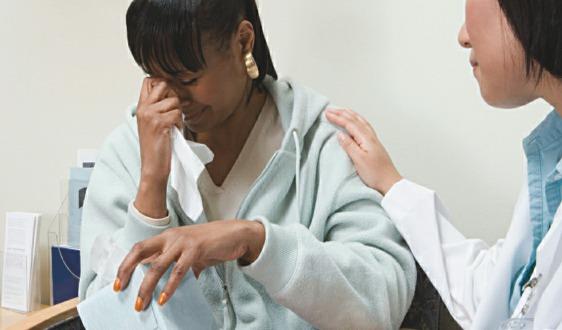
● Feel depressed, physically sick or hopeless.
● Feel like hurting yourself or hurting or yelling at the person you care for.
● Depend too heavily on alcohol or recreational drugs.
● Fight with your spouse, children, stepchildren, or other family members and friends.
● No longer take care of yourself.
The discharge planning process begins upon admission. Barlow Respiratory Hospital is a long term acute care hospital. Patients are discharged when they are ready to receive a lower level of care.
Patients will be cared for at Barlow for as long as they are able to meet Medicare Guidelines for Acute Level of Care. We want to work with patient, family, guardian/friend in order to ensure that wishes for discharge are being honored. We encourage you to take a proactive approach in this process. Make your needs/wishes known to your doctor, case manager, and social worker so that we are able to ensure a safe transfer/discharge for the patient.
Your Case Manager will work with you and make the referrals needed to facilities to check for an available bed for the patient.
Doctor sees patient frequently
Ventilator weaning
Acute medical management respiratoryrehabilitation
Patients that are not yet weaned from ventilator, or patients with trach still in continued medical management of ventilator support or wound care

● Physical therapy, occupational therapy, speech therapy
● Medical management of chronic conditions

● Tube feedings
● Doctor sees patient at least once a week and more often if necessary

● Decannulated Patients (trach removed, off ventilator support) continued daily care, assistance with activities of daily living
● Continued assistance with medications, some IV's
● Physical therapy, occupational therapy, speech therapy, wound care, tube feedings
Some patients stay long enough to gain strength or complete course of antibiotics, then go home. Some patients stay long term due to severe disability or chronic illness.

When Looking for a Facility for Your Loved Oneo and visit the facility that you are interested in. Make an appointment with an administrator or admissions coordinator. You may opt to go unannounced, to get an unbiased view of the facility.
Go with a list of questions to ask. Forexample:
● How often does the doctorvisit?
● What is the staff to patient ratio?
● What happens if there is a medical emergency?
● What sort of services are provided (Physical Therapy, Occupational Therapy, Respiratory Therapy, socialization opportunities).
● Ask an administrator how they scored on their last survey from the health department, The Joint Commission, or other accrediting body.
● Find out what sort of participation the facility will expect from you, in regards to your loved one's recovery process.

● Ask about your loved one's insurance coverage and if there is any out-of-pocketexpense.
● How does the facility look? Are you comfortable with what you see, smell, hear, sense?
● Think about other questions you would like to ask ahead of time, so you don't forget.
Talk to your about your impressions regarding your facility visit. If you like the facility let your know so that they are able to make arrangements. If you are having concerns about your loved one’s placement in a facility, consult with your case manager. We are here to help.
If patient goes home with follow up care, home health nursing may be ordered to ensure patient is taking medications correctly, check vital signs, wound care, etc.
Medical equipment is sometimes ordered according to patient's needs (walker, wheelchair, etc). Home Health nurse stays long enough to complete assessment or intervention. Home Health nurse receives orders from patient's outside primary care physician, and home physical therapy, Occupational therapy may be ordered.
IHSS is a Department of Health and Human Services program which provides services to limited income individuals who need assistance to remain safely at home. People who receive services through IHSS must meet income and resource guidelines. They are either:
● 65 years and over
● blind
● permanently disabled
● disabled children with extraordinary care needs
Individuals who need assistance to remain at home safely and independently may receive IHSS. Eligible clients either receive Supplemental Security Income (SSI) or meet income and resource guidelines. If an individual is not on SSI, they may have to pay a monthly share of cost (co-payment) which depends on monthly income. Clients also receive Medi-Cal.
Anyone can refer a potential client including:
● yourself
● neighbor
● family member
● hospital staff
● senior centerstaff
● physician office personnel
● home health agency staff

● community organizations for age 65+, blind or disabled

Once a referral is received the case is assigned to a social worker who will schedule an appointment. The social worker will conduct a needs assessment in the applicant's home. An IHSS public health nurse may be asked to visit the applicant and make a health assessment or connect the applicant with needed health-related services.
When a person qualifies for IHSS, a social worker will visit the home to assess the need for services.
Examples of some of these services are:
● bathing
● dressing
● cooking
● cleaning

● grooming
● feeding
A social worker determines needs based on the applicant's medical condition, living arrangement and resources that may already be available. The applicant's doctor will be consulted to verify the medical condition and health needs.
The IHSS client is the employer of the caregiver. Clients may contact the IHSS Caregiver Registry (874-4411) for assistance with locating a caregiver. The client is responsible for supervising the caregiver and signing time sheets. IHSS will arrange for payment once a caregiver is hired.
Dept of Health & Human Services
County of Los Angeles
2707 S. Grand Avenue
Los Angeles, CA 90007 (213) 744-4477
Mon - Fri 9 AM - 4 PM
Referrals for conservatorshp are made when patients are unable to manage their own needs.
Families wishing to assume this role will be referred to the Office of the Public Guardian.
Medicare/Medical
(800)633-4227
www.medicare.gov
(Information Services/Fraud)
Information Line (213) 974-0515
(213)974-1234
(714)750-0788
(800)854-7771
(Report abuse and neglect issues)
Elder Abuse/Adult Protective Services
(800)992-1660 or (877) 477-3646
Patients/Families receive information on how to file a complaint about concerns such as patient abuse, neglect or misappropriation of a patient's property while hospitalized.
(916)558-1784
(800)228-1019 or 626-312-1104
Barlow Respiratory Hospital has on-site physician coverage from 7AM - 7PM and from 7PM to 7AM. A physician is always on-call to respond to emergencies.
There is a 24-hour physician coverage for this unit The physicians from Presbyterian Intercommunlty Hospital will respond to emergencies.
There is a 24-hour physician coverage for this unit. The emergency room physicians from Valley Presbyterian Hospital respond to emergencies.
Barlow Respiratory Hospital - Los Angeles
Director of Case Management: Genevieve Angel, 213-250-4200 ext 3126
Case Managers: Kathleen Cubillas, 213-250-4200 ext 3157 and Erin Rosales, 213-250-4200 ext 3119
Social Worker: Charlett Davis, MSW 213-250-4200 ext 3140
VPH Health Hospital - Van Nuys
Station 818-6782-6600 ext 8360
Social Worker Jessica Hernandez, LCSW 818-6782-6600 ext 8356
Case Manager Meila Reyes, RN 818-6782-6600 ext 3392
PIH Health Hospital Whittier Attending MD
Nursing Station 562-698-0811 x12633
Social Worker Bethany Jeffrey, LCSW 562-698-0811 x12519
Case Manager Yvette Geyen, 562-698-0811 x12520
We request that you provide information regarding your health insurance coverage. If you do not have coverage you may be eligible for Medicare, Healthy Families, Medi-Cal or Charity Care. Your social worker is available to assist with providing and completing applications. Consistent with Barlow Respiratory Hospital’s mission and values, we offer financial assistance for eligible patients who cannot afford to pay for all or part of the care that they receive from our Hospital. If you would like information regarding this financial assistance program, please contact our Patient Financial Services Department at (213) 250-4200 ext. 3301.
Policies and procedures, and information about the relationship between care, treatment and services, and financial incentives are available upon request to all patients and families. Barlow Respiratory Hospital policies and procedures and any other information about patient care, patient treatments(s), patient services and financial incentives as they relate to referrals and/or use of service are available to patients, staff, licensed independent practitioners and contracted providers upon request.
Barlow Respiratory Hospital makes every effort to maintain high standards of patient care and organizational ethics. For resolution of ethical issues you feel that you may be facing, contact your caregivers to access our internal ethical review process. Patients/family members and surrogate decision-makers can access the hospital’s Ethics Committee by:
Expressing their concern to their physician, clinical or case manager, social worker, house supervisor or any direct caregiver. Requesting to have their concern addressed and discussed at the Ethics Committee.
We welcome you and your family’s involvement in your care. We want to address the expectations you and your family may have and discuss the goals and plan of care while hospitalized at Barlow Respiratory Hospital. This will promote patient safety by sharing information pertinent to your care.
An initial patient/family and caregiver team meeting is planned within the first week of your hospitalization to discuss your expectations and the plan of care. We will also schedule meetings at your request or the request of your caregiver team to update you and your family on your condition, plan of care and progress towards goals. These meetings will include discussion of potential discharge planning issues.
The Barlow Respiratory Hospital caregiver team holds a weekly meeting to discuss the patient’s condition and review the plan of care. Important information from this meeting is shared with physicians and periodically you and/or your family will be updated on the discussion. Please contact the registered nurse assigned to your care and/or the Clinical Director or Case Manager for an update at any time.
We request you select a designated spokesperson, a family member, conservator or other person who is the designated decision-maker on your behalf, who can assist you in making decisions or make the decisions on your behalf. They will receive updates from the healthcare team.
● Speak up if you and your family member has a concern.
● Appoint a spokesperson to speak on your behalf with the physician and other members of the healthcare team and to receive information.
● Know the physician who is in charge of your care.
● Know the Clinical Director of the patient care unit and the assigned Case Manager.
● Ask why tests and treatments are needed and how it will help your recovery.
Barlow Respiratory Hospital provides an open forum for patients to discuss their concerns, answer questions and assist in resolving any patient-related issues. Contact us if patients or family members have the hospital has not addressed, or wishes to file a complaint. we encourage you to contact the Joint Commission directly, by calling 800-994-6610 or by email at complaint@JointCommission.org.
Barlow Respiratory Hospital's interest is to provide the highest level of care for all of its patients. We therefore wish to promote open communication regarding any concerns about the safety or quality of care provided at any of its facilities. We encourage you to contact us with any suggestions, concerns or grievances as we strive to continually improve our care and service. Each facility has a Patient Safety Suggestion Box. Your input is welcome.
If any concern or complaint about the safety or quality of care arises, please tell any staff member. Our staff is dedicated to providing you the best possible service and we will make every effort to address and fix the problem immediately. If our initial efforts to resolve the issue are unsuccessful please contact the Clinical Director or Supervisor to assist you. Patient/family/staff conferences can be arranged to discuss issues of concern.
Barlow Respiratory Hospital also has a Grievance Committee that is dedicated to follow up on opportunities to improve care and review all concerns, complaints and grievances. You are also encouraged to report any unresolved or significant issues formally by completing the Patient/Family Concern/Grievance form. A copy is included in this Admission Packet. These forms are also available in each patient care unit, in the visitor lobby or can be obtained from the supervisor, manager or any other staff member. Once completed please give it to any caregiver, supervisor, manager, physician or other staff member. All grievance forms are forwarded to the Administration of Barlow Respiratory Hospital. Forms can also be mailed to the address shown below
Barlow Respiratory Hospital
2000 Stadium Way Los Angeles, CA 90026
Barlow Respiratory Hospital patients have the right to:
1. Considerate and respectful care, and to be made comfortable. You have the right to respect for your cultural, psychosocial, spiritual, and personal values, beliefs and preferences.
2. Have a family member or other representative of your choosing and your own physician notified promptly of your admission to the hospital.
3. Know the name of the licensed healthcare practitioner acting within the scope of his or her professional licensure, who has primary responsibility for coordinating your care, and the names and professional relationships of physicians and non-physicians who will see you.
4. Receive information about your health status, diagnosis, prognosis, course of treatment, prospects for recovery and outcomes of care (including unanticipated outcomes) in terms you can understand. You have the right to effective communication and to participate in the development and implementation of your plan of care. You have the right to participate in ethical questions that arise in the course of your care, including issues of conflict resolution, withholding resuscitative services, and foregoing or withdrawing life-sustaining treatment.
5. Make decisions regarding medical care, and receive as much information about any proposed treatment or procedure as you may need in order to give informed consent or to refuse a course of treatment. Except in emergencies, this information shall include a description of the procedure or treatment, the medically significant risks involved, alternate courses of treatment or non-treatment and the risks involved in each, and the name of the person who will carry out the procedure or treatment.
6. Request or refuse treatment, to the extent permitted by law. However, you do not have the right to demand inappropriate or medically unnecessary treatment or services. You have the right to leave the hospital even against the advice of members of the medical staff, to the extent permitted by law.
7. Be advised if the hospital/licensed health care practitioner acting within the scope of his or her professional licensure proposes to engage in or perform human experimentation affecting your care or treatment. You have the right to refuse to participate in such research projects.
8. Reasonable responses to any reasonable requests made for service.
9. Appropriate assessment and management of your pain, information about pain, pain relief measures and to participate in pain management decisions. You may request or reject the use of any or all modalities to relieve pain, including opiate medication, if you suffer from severe, chronic intractable pain. The doctor may refuse to prescribe the opiate medication, but if so, must inform you that there are physicians who specialize in the treatment of pain with methods that include the use of opiates.
10. Formulate advance directives. This includes designating a decision-maker if you become incapable of understanding a proposed treatment or become unable to communicate your wishes regarding care. Hospital staff and practitioners who provide care in the hospital shall comply with these directives. All patients’ rights apply to the person who has legal responsibility to make decisions regarding medical care on your behalf.
11. Have personal privacy respected. Case discussion, consultation, examination and treatment are confidential and should be conducted discreetly. You have the right to be told the reason for the presence of any individual. You have the right to have visitors leave prior to an examination and when treatment issues are being discussed. Privacy curtains will be used in semi-private rooms.
12. Confidential treatment of all communications and records pertaining to your care and stay in the hospital. You will receive a separate “Notice of Privacy Practices” that explains your privacy rights in detail and how we may use and disclose your protected health information.
13. Receive care in a safe setting, free from mental, physical, sexual or verbal abuse and neglect, exploitation or harassment. You have the right to access protective and advocacy services, including notifying government agencies of neglect or abuse.
14. Be free from restraints and seclusion of any form used as a means of coercion, discipline, convenience, or retaliation by staff.
15. Reasonable continuity of care, and to know in advance the time and location of appointments as well as the identity of the persons providing the care.
16. Be informed by the physician, or a delegate of the physician, of continuing health care requirements and options following discharge from the hospital. You have the right to be involved in the development and implementation of your discharge plan. Upon your request, a friend or family member may be provided this information also.
17. Know which hospital rules and policies apply to your conduct while a patient.
18. Designate visitors of your choosing or designate a support person, if you have decision-making capacity, whether or not the person is related by blood or marriage, or registered domestic partner status, unless:
● No visitors are allowed.
● The facility reasonably determines that the presence of a particular visitor would endanger the health or safety of a patient, a member of the health facility staff, or other visitor to the health facility, or would significantly disrupt the operations of the facility.
● You have told the health facility staff that you no longer want a particular person to visit.
However, a health facility may establish reasonable restrictions upon visitation, including restrictions upon the hours of visitation and number of visitors. The health facility must inform you (or your support person, where appropriate) of your visitation rights, including any clinical restrictions or limitations. The health facility is not permitted to restrict, limit, or otherwise deny visitation privileges on the basis of race, color, national origin, religion, sex, gender identity, sexual orientation, or disability.
19. Have your wishes considered, if you lack decision-making capacity, for the purposes of determining who may visit. The method of that consideration will comply with federal law and be disclosed in the hospital policy on visitation. At a minimum, the hospital shall include any persons living in your household and any support person pursuant to federal law.
20. Examine and receive an explanation of the hospital’s bill regardless of the source of payment.
21. Exercise these rights without regard to sex, economic status, educational background, race, color, religion, ancestry, national origin, sexual orientation, gender identity, gender expression, disability, medical condition, marital status, genetic information, citizenship, primary language, immigration status (except as required by federal law), registered domestic partner status, or the source of payment for care.
22. File a grievance. If you want to file a grievance with this hospital, you may do so by writing or by calling:
(213) 250-4200
The grievance committee will review each grievance and provide you with a written response within 30 days. The written response will contain the name of a person to contact at the hospital, the steps taken to investigate the grievance, the results of the grievance process, and the date of completion of the grievance process. Concerns regarding quality of care or premature discharge will also be referred to the appropriate Utilization and Quality Control Peer Review Organization (PRO).
23. File a complaint with the California Department of Public Health regardless of whether you use the hospital’s grievance process. The California Department of Public Health’s phone number and address is:
California Department of Public Health
Los Angeles District Office
3400 Aerojet Avenue, Suite 323
El Monte, CA. 91731
Phone Number: (626) 312-1104
Toll Free: (800) 228-1019
24. File a complaint with the hospital accreditation organization, The Joint Commission by contacting them in the following manner:
Office of Quality and Patient Safety
The Joint Commission
One Renaissance Boulevard
Oakbrook Terrace, Illinois 60181
E-mail: patientsafetyreport@jointcommission.org
Fax: (630) 792-5636
Patients are expected to demonstrate reasonable and responsible behavior by complying with the following responsibilities:
1. Providing accurate and complete information concerning present complaints, past illnesses, hospitalizations, medications and other matters relating to the patient’s health.
2. Asking the physician or nurse what to expect regarding pain and pain management.
3. Asking questions when instructions about care are not understood or when there is lack of understanding about what they are expected to do.
4. Following care, service or treatment plans developed or expressing concerns about the ability to follow and comply with the proposed care, service or course of treatment and understanding the consequences of not following the proposed course.
5. Participating in the care, service or treatment plans developed.
6. Accepting the consequences (outcomes) for not following the proposed care, service or treatment plan.
7. Following the Hospital’s rules and regulations concerning patient care and conduct—including demonstrating basic respect (ie., confidentiality, privacy, minimal noise) for the rights of other patients and caregivers.
8. Demonstrating consideration for the Hospital’s personnel and property.
9. Promptly meeting any financial obligation agreed to with the Hospital.
10. Providing input to staff/hospital on patient safety issues.
Barlow Respiratory Hospital 2000 Stadium Way Los Angeles, CA 90026 213.-250.4200
Barlow Respiratory Hospital 2000 Stadium Way
Los Angeles, CA 90026
(213) 250-4200
(213) 202-6800 /Fax
Barlow Respiratory Hospital at Valley Presbyterian Hospital 15107 Vanowen Street Van Nuys, CA 91405 818.782.6600
Barlow Respiratory Hospital at Valley Presbyterian Hospital 15107 Van Owen St. Van Nuys, CA 91405
(818) 782-660
Barlow Respiratory Hospital at PIH Health Hospital, Whittier 12401E. Washington Blvd. Whittier, CA 90602 562.698.0811
Barlow Respiratory Hospital at Presbyterian Intercommunity Hospital 12401 Washington Boulevard
Barlow Respiratory Hospital patients can access their medical records in two ways:
1: Enroll for our secure online Barlow Respiratory Patient Portal
As an added convenience, Barlow Respiratory Hospital patients can access their health information with our secure online Patient Portal You can access information online from any computer device and share the information with your healthcare team or designated caregivers. An Accessibility Patient Portal is also available for patients to use screen readers (for the visually impaired), language translators (for translating to other languages) or other accessibility tools.
We encourage all patients to enroll and actively participate in their healthcare. Once enrolled, you can view laboratory and radiology reports, medications, allergies, demographic information, visit history and discharge/aftercare information.
The best way to enroll is during your stay at Barlow Respiratory Hospital (Main campus in Los Angeles, Valley Presbyterian / Van Nuys, and Presbyterian Health Hospital / Whittier locations). For more information, call the Health Information Management (Medical Records) department during business hours at 213-250-4200 x 3337, or email HIMROI@barlowhospital.org.
Business hours are Monday - Friday 8:00 AM - 4:00 PM; closed weekends and holidays.
2: Request records with authorization sent by mail, email or fax.
1. If the Patient Portal is not used, a written authorization is required for the request to have your medical records released.
2. Download, print, fill out and sign the Authorization for Use and Disclosure of Health Information form from the Barlow Respiratory Hospital website.
3. Deliver the completed authorization form to:
• Mail: Barlow Respiratory Hospital
Attention: Health Information Management Department – Building 17 2000 Stadium Way Los Angeles, CA 90026
• Phone: 213-250-4200 X 3337
• Fax: 213-202-6490
• Email: HIMROI@barlowhospital.org
Federal law requires us to give you this information. We hope this information will help increase your control over your medical treatment.
Your doctors will give you information and advice about treatment. You have the right to choose. You can say “Yes” to treatments you want. You can say “No” to any treatment that you don’t want – even if the treatment might keep you alive longer.
If you haven’t named a surrogate, your doctor will ask your closest available relative or friend to help decide what is best for you. Most of the time that works, but sometimes everyone doesn’t agree about what to do. That’s why it is helpful if you can say in advance what you want to happen if you can’t speak for yourself.
Your doctor must tell you about your medical condition and about what different treatments and pain management alternatives can do for you. Many treatments have “side effects.” Your doctor must offer you information about problems that medical treatment is likely to cause.
Often, more than one treatment might help you – and people have different ideas about which is best. Your doctor can tell you which treatments are available to you, but your doctor can’t choose for you. That choice is yours to make and depends on what is important to you.
In fact, it is better to choose before you get very sick or have to go into a hospital, nursing home, or other healthcare facility. You can use an to say you want to speak for you and kind of treatments you want. These documents are called “advance” because you prepare one before healthcare decisions need to be made. They are called “directives” because they state who will speak on your behalf and what should be done.
Patients often turn to their relatives and close friends for help in making medical decisions. These people can help you think about the choices you face. You can ask the doctors and nurses to talk with your relatives and friends. They can ask the doctors and nurses questions for you.
In California, the part of an advance directive you can use to appoint an agent to make healthcare decisions is called a The part where you can express what you want done is called an

You may tell your doctor that you want someone else to make healthcare decisions for you. Ask the doctor to list that person as your healthcare “surrogate” in your medical record. The surrogate’s control over your medical decisions is effective only during treatment for your current illness or injury or, if you are in a medical facility, until you leave the facility.
You can if you are 18 years or older and are capable of making your own medical decisions. You do not need a lawyer. You can choose an adult relative or any other person you trust to speak for you when medical decisions must be made.
Usually, a healthcare agent will make decisions only after you lose the ability to make them yourself. But, if you wish, you can state in the that you want the agent to begin making decisions immediately.
treatment would be bad medical practice or ineffective in helping you. If this causes disagreement that cannot be worked out, the provider must make a reasonable effort to find another healthcare provider to take over your treatment.
After you choose your agent, talk to that person about what you want.
Sometimes treatment decisions are hard to make, and it truly helps if your agent knows what you want. You can also write your wishes down in your advance directive.
Absolutely. You will still get medical treatment. We just want you to know that if you become too sick to make decisions, someone else will have to make them for you.
Remember that:
You can still write out your wishes in your advance directive, without naming an agent. Youcan say that you want to have your life continued as long as possible. Or you can say that you would not want treatment to continue your life. Also, you can express your wishes about the use of pain relief or any other type of medical treatment.
Even if you have not filled out a written , you can discuss your wishes with your doctor, and ask your doctor to list those wishes in your medical record. Or you can discuss your wishes with your family members or friends. But it will probably be easier to follow your wishes if you write them down.
• A lets you name an agent to make decisions for you. Your agent can make most medical decisions – not just those about lifesustaining treatment – when you can’t speak for yourself. You can also let your agent make decisions earlier, if you wish.
• YOU CAN CREATE AN
by writing down your wishes about health care or by asking your doctor to record your wishes and place in your medical file.
If you know when you would or would not want certain types of treatment, an Instruction provides a good way to make your wishes clear to your doctor and to anyone else who may be involved in deciding about treatment on your behalf.
may be used together or separately.
You can change or cancel your advance directive or the person you want to make your healthcare decisions, at any time if you are able to communicate your wishes.
The same rules apply to anyone who makes healthcare decisions on your behalf – a healthcare agent, a surrogate whose name you gave to your doctor, or a person appointed by a court to make decisions for you. All are required to follow your or, if none, your general wishes about treatment, including stopping treatment. If your treatment wishes are not known, the surrogate must try to determine what is in your best interest.
The people providing your health care must follow the decisions of your agent or surrogate unless a requested
Ask your doctor, nurse, social worker, or healthcare provider to get more information for you. You can have a lawyer write an advance directive for you, or you can complete an advance directive by filling in the blanks on a form.

This document provides written information regarding the benefits, risks and alternatives of transfusion of blood product (including red blood cells, plasma, platelets or others) collected from the patient (autologous) or another person. This material serves as a supplement to the discussion you have with your physician. It is important that you fully understand this information, so please read this document thoroughly. If you have any questions regarding the procedure, ask your physician prior to consenting to receive a transfusion.

Transfusions of blood products are provided to increase the amount of blood components in your body when they are below a reasonable level for your health. The transfusion may be made up of red blood cells, plasma, platelets or other specialized products made from blood. Your physical will decide on the right amount and type of blood product based on your medical condition or diagnosis.
Transfusion of blood products may be necessary to correct low levels of blood components in your body, and may also make you feel better. In some cases, failure to recreive transfusion(s) may result in death.
Known risks of this treatment include, but are not limited to:
Irritation,
● Temporary reaction such as a fever, chills or skin rashes.
Other rare but more serious complications include severe allergic reactions, heart failure due to fluid overload, acute pulmonary edema (fluid leaking into the lungs), hemolysis (destruction of red blood cells), shock or death.
June 2016
Transfusion of blood products carry a very small risk of transmission of infectious diseases such as HIV (about 1 in 1.2 million) and Hepatitis B (about 1 in 1 million). Other significantinfectionsmayalsobetransmittedbytransfusion, but overall, this risk is low.
If you need blood you have several options. Most patients requiring transfusion receive blood products donated by volunteer community donors. These donors are extensively screened about their health history and undergo numerous blood tests as mandated by state and federal regulations in order to ensure the safest possible blood supply. Alternatives to transfusion with blood products from volunteer community donors include:
● Pre-operative autologous donation (using your own previously donated blood), see below for more information.
● Directed donation (blood donated by people who have asked to donate for you), see below for more information
● Intra-operative autologous transfusion/hemodilution (collecting your own blood during surgery to be given back to you).
● Medications (certain medications may increase blood volume prior to surgery or reduce active bleeding to lessen the need for transfusion.
These options may be available only if your health, time and procedure permit. They may not be available at all locations or for all patients. You may also choose not to receive blood transfusion; however, this decision may hold life-threatening consequences.
Pre-operative autologous donation is not approprate for all patients. Autologous donation involves collecting our own blood prior to a planned surgery for storage in the hospital blood bank. It is important to discuss with your physician if it is safe for you to donate and the likelihood
of needing a transfusion based on your surgery and current transfusion guidelines. Receiving your own blood may reduce, but will not eliminate the risk of transfusion-related complications. Insurance company policies may vary regarding reimbursemet for this service. Overall, although autologous donation is an option to consider for those who qualify, the number of autologous donations in the United States has significantly decreased in the last few decades primarily due to major advances in blood safety and efforts to decrease unnecessary blood transfusions.
Directeddonationreferstobloodcollectedfrom“directed donors” who are donating blood for a specific patient by request. Directed donors are often family and friends of the patient. Directed donors go through the same qualification process as volunteer donors. Directed donations are not considered to be safer than the general blood supply.
References:
Circular of Information for the Use of Human Blood and Blood Components. AABB. Nov 2013 (revised April 2014)
AABB Technical Manual. 18th Edition.
This brochure was developed by the California Department of Health Services, Laboratory Field Services (850 Marina Bay Parkway, Richmond, CA 94804)
In partnership with the Medical Technical Advisory Committee of the Blood Centers of California.


For information about brochure contents, please call Laboratory Field Services 213 620-6574
Distributed by the Medical Board of California. To place an order for this brochure, please FAX your request to: (916) 263-2479
This informaton may be obtained electronically at:
http://www.mbc.ca.gov/Publications/ Brochures/Blood_Transfusions.aspx
Revised 06/2016
Sign up TODAY to be a registered organ and tissue donor. When you apply for or renew your driver license or identification card, simply check the box – ”Add my name to the donor registry.”
By becoming an organ and tissue donor, you give life and hope to others. When you add your name to the you are legally authorizing the recovery of organs and tissues in the event of your death.
Registering as a donor will not affect your medical treatment in any way. A pink "DONOR" dot will be printed on your driver license or state identification card. Your name, mailing address, birth date, driver license or identification card number and gender will be transmitted to the Donate Life California Organ & Tissue Donor Registry.
Your donation of organs could save eight lives and your tissue donation can enhance the lives of another 50 people. Organs for life-saving transplants include heart, liver, kidneys, lungs, pancreas, and small intestine. Tissues that could save or enhance someone's life include corneas, heart valves, bones, and skin grafts.
Historically, while signing a donor card and placing the pink "DONOR" sticker on your license served as an important symbol of your intent, it did not place you on any list or registry. Now, through the Department of Motor Vehicles, the Donate Life California Organ & Tissue Donor Registry guarantees that your desire to donate is stored in a secure, confidential database. The information is accessible only to authorized organ and tissue recovery personnel.
Prior to the registry, the responsibility for giving consent for donation fell solely on the donor's family. Unfortunately, family members are not always aware of their loved one's wish to donate. Registering with Donate Life California Organ & Tissue Donor Registry eliminates any doubt about your wish to be a donor. Your family will be provided proof of your registration at the hospital so that your life-saving wishes can be fulfilled.
Your registration will serve as a Document of Gift as outlined in the California Uniform Anatomical Gift Act. A Document of Gift, not revoked by the donor before death, is irreversible and does not require the consent of any other person. Should your death result in the opportunity for you to be a donor, an official record of your authorization will be readily available and cannot be overturned by your family. If you are medically eligible to donate, your wishes will be respected and your family will be relieved of making a decision on your behalf. Parental or guardian consent is required for persons under 18.
If you would like the pink "DONOR" dot to be printed on the front of your license and are currently registered with the Donate Life California Organ & Tissue Donor Registry, y on the driver license and identification card application. If you previously registered with the Donate Life California Organ & Tissue Donor Registry and wish to remove your name from the donor registry, please contact Donate Life California.
A donation limitation states you do NOT authorize particular organs and/or tissues to be recovered or used for specific purposes. If you wish to limit your donation, simply go to the registry website (www.donateLIFEcalifornia.org) and click on Registry and then Update Donor Profile, or contact Donate Life California by phone or email.
The Donate Life California Organ & Tissue Donor Registry allows you to express your commitment to become an organ and tissue donor. The registry guarantees your plan to donate will be carried out when you die.
● More than 21,000 Californians are waiting for a second chance at life; you can give them that chance.
● About 20% of those nationwide waiting for an organ transplant are Californians.
● Of those waiting, one out of three will die due to a lack of life-saving donors.
● Organs and tissues are distributed fairly and equitably based on medical criteria only.
● Your medical care and/or funeral arrangements will not be affected by your decision to donate.
● Donation costs you and your family nothing.
● People of all ages and medical histories can sign up to be potential donors.
● All major religions support or permit donation.
on the driver license and identification card application form and call us at Donate Life California 866-797-2366. Donate Life California representatives can answer any questions you may have about your opportunity to be a donor.
Donate Life California is the nonprofit agency that administers the state authorized organ and tissue donor registry in partnership with California's four nonprofit, federally-designated organ recovery agencies: California Transplant Donor Network, Lifesharing, OneLegacy and Sierra Donor Services. As a state authorized public service, the registry assures that all personal information is kept confidential and stored in a secure database, accessible only to authorized organ and tissue recovery personnel.
For more information, contact:
Donate Life California
3465 Camino Del Rio South, Ste. 410 San Diego, CA 92108
info@donateLIFEcalifornia.org
www.donateLIFEcalifornia.orgEnglish: 1-866-797-2366
www.doneVIDAcalifornia.orgSpanish: 1-866-797-2366

CHINESE – SIMPLIFIED
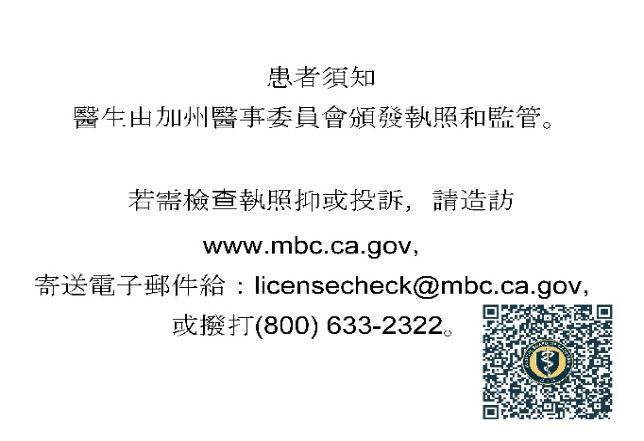

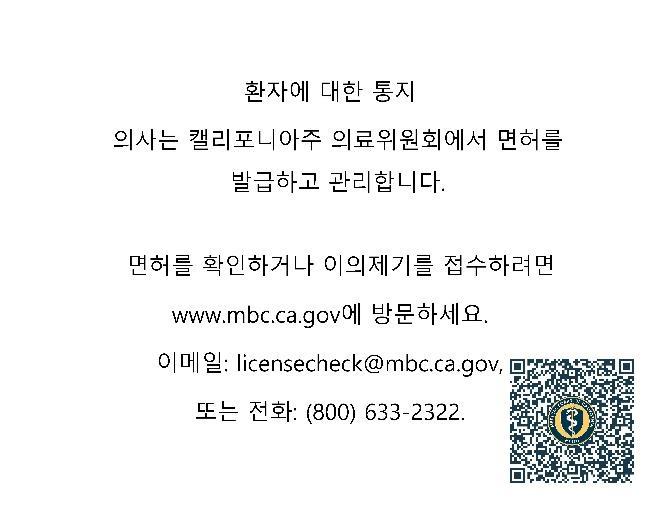
CHINESE – TRADITIONAL
VIETNAMESE
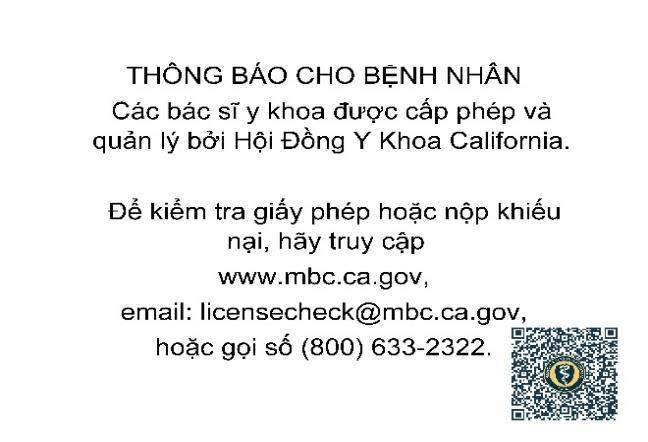
TAGALOG

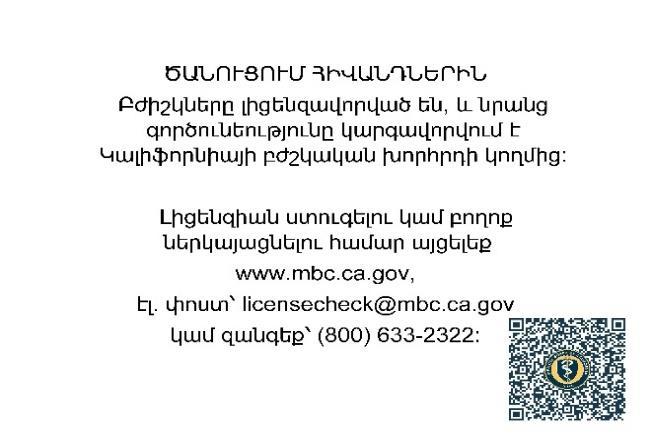

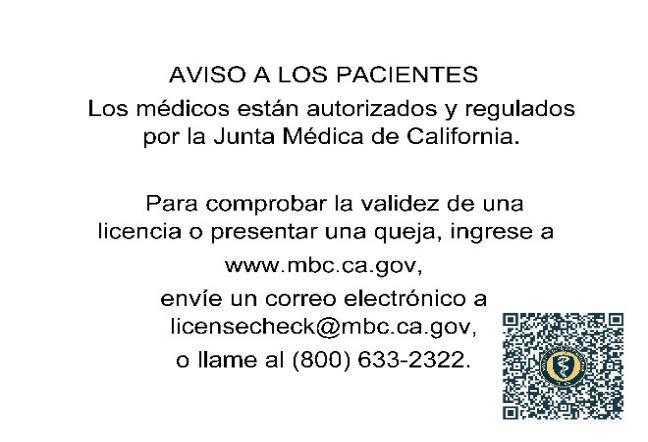
PUNJABI-INDIA
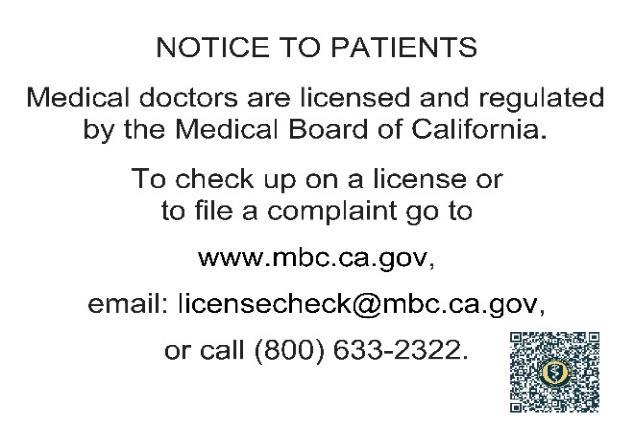
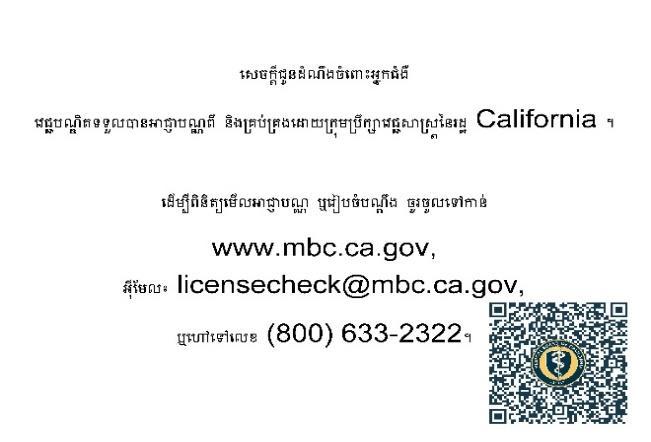


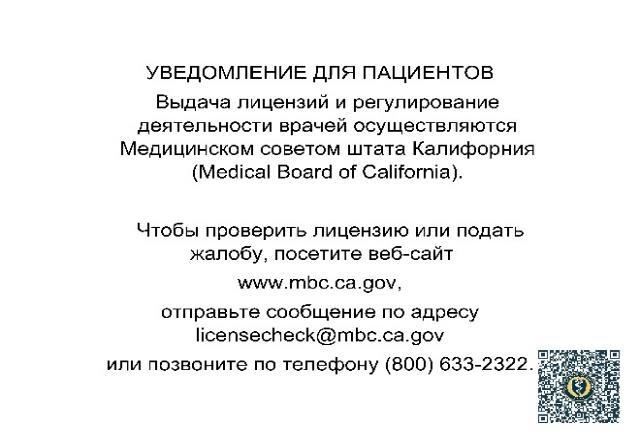
PUNJABI-PAKISTAN
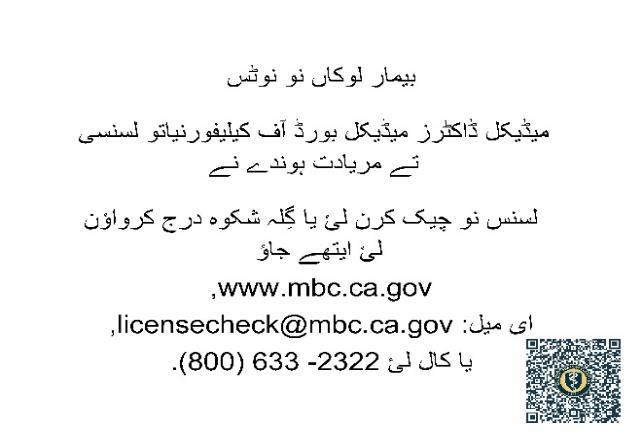

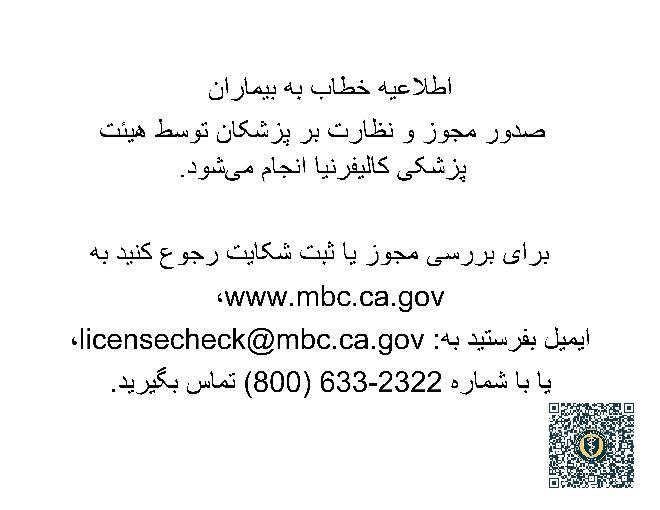
CHINESE – SIMPLIFIED



CHINESE – TRADITIONAL
VIETNAMESE

TAGALOG




PUNJABI-INDIA





PUNJABI-PAKISTAN



Medical doctors are licensed and regulated by the Medical Board of California.
To check up on a license or to file a complaint go to www.mbc.ca.gov
email: licensecheck@mbc.ca.gov or call (800) 633-2322.
________________________
Date _______________
Date
Original to be maintained in patient’s medical records
Patient’s Name (Type or Print) _________________________
Patient’s Signature _________________________
Patient Representative’s Name and Relationship (Type or Print) _________________________
Patient Representative’s Signature
IMPORTANT
:
Dr. _________________________________________ Phone Number ___________________________
Dr. _________________________________________ Phone Number ___________________________
Charge Nurse _________________________________________________________________________
Nurse Manager ________________________________________________________________________
____________________________________________________________________________________________
